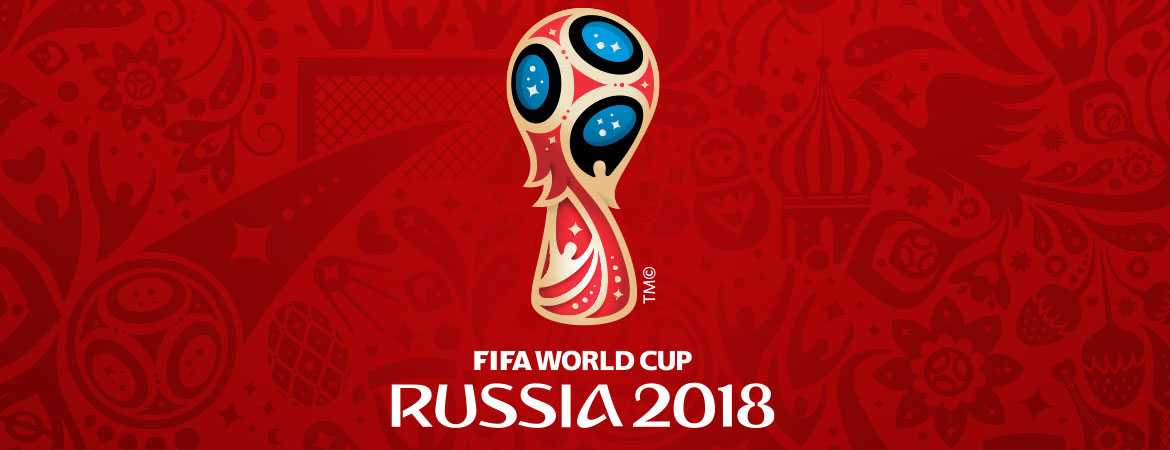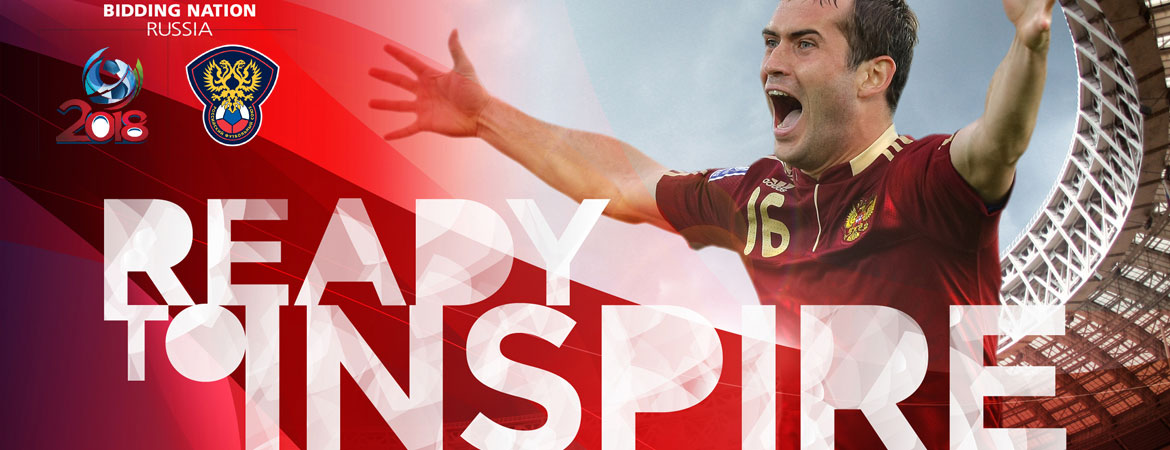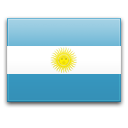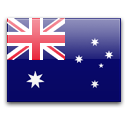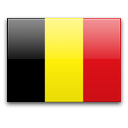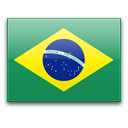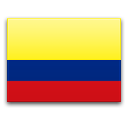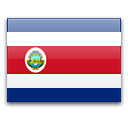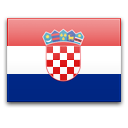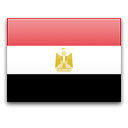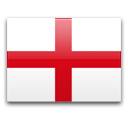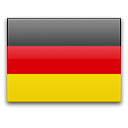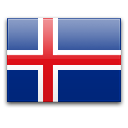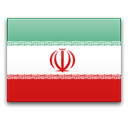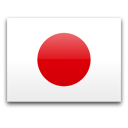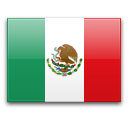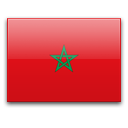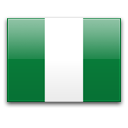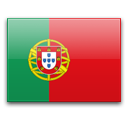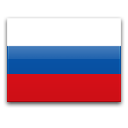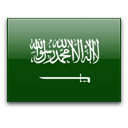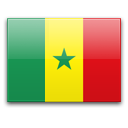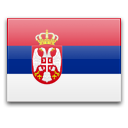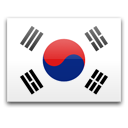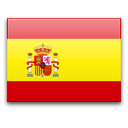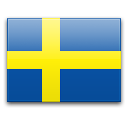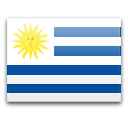| Bookmarer | Bonus | Rate | Language | Overview | Site |
|---|---|---|---|---|---|
 | 50 / 50 | 5/5 | Overview | Go To the Site | |
 | 100 | 5/5 | Overview | Go To the Site | |
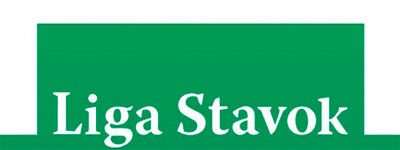 | 100$ | 5/5 | Overview | Go To the Site | |
 | 100$ | 5/5 | Overview | Go To the Site |
FIFA 2018 in Russia| Football World Cup 2018 | Fifa World Cup 2018
Whether you are a football fan or not, it is doubtless you will hear everyone talking about the World Cup. This year it will be the 21st FIFA World Cup which is scheduled to take place in Russia (since Russia was awarded the hosting rights on 2 December 2010) from 14 June to 15 July 2018. It has been almost twelve years since the World Cup was held in Europe and four since the country hosted Olympics in Sochi. The host team is automatically qualified to the final tournament, which will also include other 31 teams. Of all the 32 teams, 20 will be making back-to-back appearances following the previous tournament in 2014. Iceland and Panama will be making their very first appearances at the FIFA World Cup. 64 matches will be played in 12 venues which are located in 11 cities. However, the final will take place at the Luzhniki Stadium in Moscow the capital of Russia on the last day of the World Cup.
Sponsored: LuckyMash 🎰 (VIP Casinos)
Soccer World Cup 2018 in Russia
World Cup FIFA 2018 – the most significant sporting event of the year. It will be held in Russia. This vast country is located immediately on two continents, what makes the event doubly unique. This is the 21st world championship in history and Russia will become the host country of the tournament for the first time.
 New Casino Offers 2024
New Casino Offers 2024
The level of awareness of the FIFA World Cup remains extremely high: 95% of online respondents interviewed in Russia know about the tournament, of which 74% said they are interested in the event. On average, in the world (an average of the 24 countries participating in the study), 88% of the audience heard about the championship, 74% of them also expressed enthusiasm for the tournament. Thus, from the point of view of world awareness, the FIFA World Cup is the most popular sporting event; After that, with a small margin followed by the Summer and Winter Olympics. In Russia, the FIFA World Cup holds the first place regarding awareness with the Winter Olympics, outperforming the Summer Olympics. 77% of respondents in Russia agree that the country will be a good host for the FIFA 2018 World Cup, 54% of respondents in the world think so.
Groups
Group A
| # | Team | Played | Won | Draw | Lost | +/- | Points |
|---|---|---|---|---|---|---|---|
| 1 | 3 | 3 | 0 | 0 | +5 | 9 | |
| 2 | 3 | 2 | 0 | 1 | +4 | 6 | |
| 3 | 3 | 1 | 0 | 1 | -5 | 3 | |
| 4 | 3 | 0 | 0 | 1 | -4 | 0 |
- Russia - Russian team’s advantage is a clear gameplan and a switch to a back three.
- Uruguay - Uruguay claims to be strong for its Luis Suárez and Edinson Cavani.
- Egypt - Egypt’s Héctor Cúper builds his team on a stable defense.
- Saudi Arabia - Saudi Arabia’s Salem al-Dawsari, Fahad al-Muwallad, and Yahya al-Shehri are the best players in the team who expect to test any defense in this year’s World Cup.
Group B
| # | Team | Played | Won | Draw | Lost | +/- | Points |
|---|---|---|---|---|---|---|---|
| 1 | 3 | 1 | 2 | 0 | +1 | 5 | |
| 2 | 3 | 1 | 2 | 0 | +1 | 5 | |
| 3 | 3 | 1 | 1 | 1 | 0 | 4 | |
| 4 | 3 | 0 | 1 | 2 | -2 | 0 |
- Portugal - Well-known Portugal player Cristiano Ronaldo is always in the middle of things, although players like Bernando Silva and Gelson Martins are team’s advantages as well.
- Spain - Spain is stated to be one of the most powerful teams at the World Cup led by David Silva, Sergio Busquets, and many other talented members.
- Iran - Since four years ago Iran started to look way stronger, known for Sardar Azmoun, Karim Ansarifard and others.
- Morocco - Morocco is a team of great promise led by Renard and Ajax’s Hakim Ziyech, one of the most talented playmakers in Europe.
Group C
| # | Team | Played | Won | Draw | Lost | +/- | Points |
|---|---|---|---|---|---|---|---|
| 1 | 2 | 2 | 0 | 0 | +2 | 6 | |
| 2 | 2 | 1 | 1 | 0 | +1 | 4 | |
| 3 | 2 | 0 | 1 | 1 | -1 | 1 | |
| 4 | 2 | 0 | 0 | 2 | -2 | 0 |
- France - France is one of the favorites to win this year’s crown with the help of frightening players such as Anthony Martial and Alexandre Lacazette.
- Peru - A blend of determination, creativity, and discipline was added to Peru team with the help of Ricardo Gareca.
- Australia - Denmark - Denmark team have one of the best players in Europe — Christian Eriksen who will surely make an effort for his country to win the World Cup 2018. A new manager Bert van Marwijk (since November) hasn’t had enough time to analyze the team, although he claims to aim to tighten the defense with the help of his players such as Leckie and Robbie Kruse.
Group D
| # | Team | Played | Won | Draw | Lost | +/- | Points |
|---|---|---|---|---|---|---|---|
| 1 | 2 | 2 | 0 | 0 | +5 | 6 | |
| 2 | 2 | 1 | 0 | 1 | 0 | 3 | |
| 3 | 2 | 0 | 1 | 1 | -3 | 1 | |
| 4 | 2 | 0 | 1 | 1 | -2 | 1 |
- Argentina - Argentina, popular for five-time world player of the year Lionel Messi, seems to be riding a rollercoaster since 2014 when the team hardly made it to the World Cup. They haven’t impressed football fans very much since they only won once in four official matches.
- Croatia - Croatia, one of the oldest teams in the tournament, is predicted to have a lot of possession with Luka Modric, Ivan Perisic, Mario Mandzukic and Ivan Rakitic.
- Iceland - The smallest country at the World Cup (330.000 citizens) Iceland showed an unforgettable experience and determination at the Euro 2016 when the team knocked out England. Fans are now expecting even more success from Iceland team. The well-known star Gylfi Sigurdsson must do his best since he is critical to his team.
- Nigeria - Nigeria’s coach Gernot Rohr has brought some discipline, crucial stability and fighting spirit into his team since 2016, which made the squad absolutely talented.
Group E
| # | Team | Played | Won | Draw | Lost | +/- | Points |
|---|---|---|---|---|---|---|---|
| 1 | 2 | 1 | 1 | 0 | +2 | 4 | |
| 2 | 2 | 1 | 1 | 0 | +1 | 4 | |
| 3 | 2 | 1 | 0 | 1 | 0 | 3 | |
| 4 | 2 | 0 | 0 | 2 | -3 | 0 |
- Brazil - The coach, Adenor Bacchi (also universally known as Tite), has made Brazil team into one of the favorites to win this year’s tournament. Furthermore, since the humiliating defeat (7-1) against Germany in 2014 World Cup, the team’s attack has been almost unbreakable, led by the star player Neymar, who is still on the peak of his game. They also were the first ones to clinch qualification for Russia.
- Switzerland - Switzerland team which only lost once reached Russia via the playoffs with the help of their coach Vladimir Petkovic. He says, ‘The team have grown together and keep working hard for each other’. Although it is often difficult for goals to come by, the team’s members have collective behavior which gives Switzerland’s fans hope for their win. Moreover, a big part of Switzerland team consists of the players from the 2009 Under-17 world champion, all of which have deep tournament experience. However, some critics aren’t satisfied with the way the team was qualified (straight wins in one weak group and a penalty call while playing against Northern Ireland).
- Costa Rica - Óscar Marímez, Costa Rica’s coach, has always been focused on defense (led by Giancarlo González and Óscar Duarte) and fast counterattacks since his team reached the final eight in Brazil in 2014. The team’s star Keylor Navas is stated to be the best-known player in the squad. This year it will be the fifth time Costa Rica team appears at the World Cup.
- Serbia - Mladen Krstajic, present Serbia team’s coach, took over from Slavojub Muslin in October last year and since then has changed many things. For example, he takes to a 4-2-3-1 formation. The team scored the most goals (20 in the group!) with the help of Aleksandar Mitrovic, the leading scorer. What is more, Sergej Milinkovic-Savic is one of the most popular players in the whole world and, along with Dusan Tadic, has all chances to reach the final. However, as center-back Matijia Nastasic is injured, the team is much weaker than it could have been with him.
Group F
| # | Team | Played | Won | Draw | Lost | +/- | Points |
|---|---|---|---|---|---|---|---|
| 1 | 2 | 2 | 0 | 0 | +1 | 6 | |
| 2 | 2 | 1 | 0 | 1 | 0 | 3 | |
| 3 | 2 | 1 | 0 | 1 | 0 | 3 | |
| 4 | 2 | 0 | 0 | 1 | -1 | 0 |
- Germany - Germany team have already received a trophy in Russia (in the build-up to the World Cup), due to their win in the Confederations in July. The team’s qualifying results shock: 10 wins out of 10 and a new European record (43 goals). They are one of the favorites to win this year’s World Cup with the help of their coach Joachim Löw and the most sought-after players such as Toni Kroos, Mesut Özil, and Sami Kherdira. However, without players like Per Mertesacker and Philipp Lahm there is now a lack of leadership in the collective.
- Mexico - The things aren’t as good for Mexico team whose nation experts expect them to come up just short the way they did the last six World Cups. But Mexicans will reach success provided they are not knocked out until the quarter-finals this year. It was only done two times (in 1970 and 1986). The team has all chances to do that, especially after their impressive qualifying in Brazil in 2014.
- Sweden - It will be Sweden’s first time at the World Cup finals this year since 2006. Now Manchester United’s fans ask themselves if the striker of the team comes out of his retirement for one last World Cup. Another question is whether his ex-co-members will be glad to accept him back into their team as now they seem to be more well-structured and have good relationships.
- South Korea - South Korea has been competing in the tournament ever since the year 1986. Top-level football players such as Lee Chung Yong and Son Heung Min bring their team very valuable experience playing 4-2-3-1 and led by coach Shin Tae Yong. South Korea team showed the unforgettable skill of one of members Son Heung Min (one of the most top-scoring Asian player in Premier League history) who proved he can play in different positions. However, some critics do not think South Korea will go through this year.
Group G
| # | Team | Played | Won | Draw | Lost | +/- | Points |
|---|---|---|---|---|---|---|---|
| 1 | 2 | 2 | 0 | 0 | +6 | 6 | |
| 2 | 2 | 2 | 0 | 0 | +6 | 6 | |
| 3 | 2 | 0 | 0 | 2 | -4 | 0 | |
| 4 | 2 | 0 | 0 | 2 | -8 | 0 |
- Belgium - Belgium team are ranked among the five in the world. Their coach Roberto Martínez has brought passion to his team although De Bruyne criticises Martínez for choosing wrong tactics, especially after 2017 November (3-3). Nevertheless, Belgium still has three high-quality players (Romelu Lukaku, Eden Hazard, and Dries Mertens) who will make sure to break through any attacks or defense.
- England - Some say England team’s present coach Gareth Southgate has made his team much better than Roy Hongson (especially in 2016). However, his ‘three-man defense’ tactics are still not tested in tournaments or any other competitive games. Not even talking about the tough enemies. Furthermore, since England lost to Iceland in the round of 16 at Euro 2016, the team’s fan’s expectations have decreased very much. Despite this fact, England team still have Harry Kane, this year’s world top striker scoring freely for his club in the Champions League and Premier League (12 goals in 23 games).
- Tunisia - Tunisia’s team are finally entering for the fifth time the World Cup after 12 years to show the strength and skills of their new members such as Wahbi Khazri, Aymen Abdennour, and others. They are stated to be aiming for the win this year. 27-year-old Youssef Msakni owns his fan’s hopes and expectations after playing the key role in qualifying and scoring a hat-trick in an away win to Guinea. However, Msakni’s injury has left a vast gap for their coach Nabil Maâloul to fill.
- Panama - Panama’s team are known for their strong spirit and stability. Even in the friendly match against Denmark in March showed they would never give up. Even in spite of Román Torres’ injury (because of which he will not travel to Russia this year), the team has their striker Luis Tejada who scored 43 goals for Panama.
Group H
| # | Team | Played | Won | Draw | Lost | +/- | Points |
|---|---|---|---|---|---|---|---|
| 1 | 2 | 1 | 1 | 0 | +1 | 4 | |
| 2 | 2 | 1 | 1 | 0 | +1 | 4 | |
| 3 | 2 | 1 | 0 | 1 | +2 | 3 | |
| 4 | 2 | 1 | 1 | 0 | -4 | 0 |
- Poland - Poland ranked in the top 10 in the entire world are known for winning 8 out of 10 qualifies and scoring an average of 2.8 goals per game. The team has two strongest players: Robert Lewandowski (striker) and Arkadiusz Milik who has recently recovered from two quite serious knee injuries. Despite this fact, Poland had one of the worst defenses of all European group winners, according to the experts. Thus, the team’s coach Adam Nawalka is considering a replacement for his favored 4-2-3-1. Probably, he will go with a back three position.
- Colombia - Colombia’s team is one of the best sought-after ones due to their breakthrough into the quarter-finals in Brazil in 2014. What is more, in a perfect shape arrive in Russia two club’s stars — Radamel Falcao and James Rodrígez. However, the other Colombia team’s player David Ospina might not be as good because of not very regular plays at Arsenal and mistakes that he made for the national team not so long ago. Much credit for bringing the team back into the World Cup this year gets the coach Jose Pekerman.
- Senegal - All true football fans remember Senegal’s unforgettable debut in 2002. They beat France team who were known as ‘defending champions’ back then. Now Senegal is back with Sadio Mane as the team’s key player and Aliou Cissé as their coach who used to be the captain of the 2002 team and was criticized for his tactics. Nevertheless, the team still have Kalidou Koulibaly (defense), Badou Ndiaye (midfield), Sadio Mané (up front), and Idrissa Gana Gueye (midfield).
- Japan - Enemies of Japan team should be aware that Keisuke Honda, Shinji Okazaki, and Shinji Kagawa’s impressive trio is back and they are all ready to lift the team on and off the pitch. However, the team’s coach Akira Nishino has failed while trying a 3-4-2-1 formation because of the struggles of his team trying to adapt to new positions.
The History of the FIFA World Cup
Every four years millions of fans from around the world watch the best soccer players in the world competing for the most prestigious soccer cup – FIFA World Cup. FIFA, a.k.a. The Fédération Internationale de Football Association was founded in May 1904, in Paris. The foundation act was signed by the representatives of seven countries: France, Switzerland, Netherlands, Belgium, Sweden, Denmark and Spain. Surprisingly, the English, who are considered the inventors of soccer, were not involved in the creation of this international organization. The first official international match took place in May 1904 in Brussels between the teams of France and Belgium. After that, it was clear that the idea of forming an international soccer organization is valid and should be brought to life. FIFA Statutes were laid down, which at that time had the following points:
- Clubs and players could not play simultaneously for different national associations;
- National associations attending the first congress were exclusively recognized;
- The matches played should follow the Laws of the Game of the Football Association Ltd;
- National association were to pay an annual fee of FF50;
- FIFA had the exclusive rights to organize international competitions.
The regulations came into force in September 1904. The representatives of German FA also supported these principles.
The First FIFA World Cup
In 1900 and 1904 football was included in the Olympic Games as an exhibition, and since 1908 it was officially a part of the Olympic Games. It was a great success and seeing this FIFA wanted to hold its own world championship. A special committee headed by the president Jules Rimet was created to examine the question of conducting FIFA World Cup. Countries who were members of the organization were asked whether they would like to hold a tournament and under what conditions.
At the FIFA Congress in Amsterdam in May 1928 it was decided to organize a world championship. Countries such as Sweden, Spain, the Netherlands, Italy, and Hungary proposed their candidatures. However, Uruguay was the favorite since its national organization promised to cover all the costs including accommodation and the travel expenses of the teams. So in 1929, Uruguay was assigned to be the first country to hold the FIFA World Cup. The first FIFA World Cup opened on July, 18th 1930 in Montevideo and it began the new era of the world football. Because of the tense political situation in Europe, only four European countries participated in the tournament in 1930: France, Belgium, Yugoslavia, and Romania. In total, 13 states took part in this first tournament: four from Europe, seven from South America and two from North America. The first two matches between France and Mexico, and the USA and Belgium took place simultaneously. In the final game of the tournament, Uruguay defeated Argentina, and they are the first national team to win the FIFA World Cup.
However, Uruguay association was quite offended by the fact that only a few European countries showed up and they refused to defend their title at the next tournament four years later. In four years Italy was chosen to be the host of the World Cup. 16 teams participated after going through qualifying rounds. At this cup, there were only knockout rounds, and the teams which lost (including Argentina and Brazil) went home after just one match. The final was between Czechoslovakia and Italy with Italy prevailing. This final for the first time was transmitted on the radio. In 1938 the World Cup took place in France with Italy defending their title. Because of the outbreak of World War Two, the tournament in 1942 didn’t take place. Finally, in 1946 the Congress met again, and this time 34 organizations were represented here. From this time the FIFA World Cup trophy was named after Jules Rimet and was called Jules Rimet Cup. Since 1958 the World Cup was alternatively held in the Americas or Europe until in 1996 Japan and Korea were selected to co-host the tournament in 2002.
The History of the FIFA World Cup Trophy
Jules Rimet Cup – The first trophy was created by the French sculptor Abel Lafleur. It depicted Nike, the Greek goddess of victory holding a cup. Its story is interesting. During the war, the trophy was kept by Ottorino Barassi, the Italian Vice-President of FIFA, who kept it under his bed to save it from the occupants. In 1966 the cup disappeared from a public exhibition at Westminster Central Hall and was later found by a dog named Pickles. In 1983 the trophy was stolen in Rio de Janeiro and never found again. Supposedly, it was melted down by thieves. A replica of the cup was made for Brazilian Football Association who won the cup three times. The original trophy weighed about 3.8 kg, and it was 35 cm high. It was made of gold and silver and semi-precious blue stone (lapis lazuli) as a base. The names of the winning teams were engraved on a gold plate on the four sides of the trophy base.
FIFA World Cup Trophy – FIFA commissioned a new trophy to be created for the tenth World Cup in 1974. The organization received 53 designs of the cup, and the final choice was the trophy created by the Italian artist Silvio Gazzaniga, who would later also design the UEFA Super Cup and the UEFA Cup. Gazzaniga actually made a prototype of the trophy and sent a photo of it to the FIFA committee. The trophy symbolizes dynamism, energy and powerful harmony, and it depicts two people holding the globe. This trophy weighs 6175 grams, and it is 36 cm high. The base is made of two layers of malachite, which resembles a football field with its green color. The winners are engraved at the bottom side of the trophy, and there will be no room to engrave more teams after the World Cup of 2038. The trophy was unveiled to the public in 1974. Germany was the team that won the World Cup that year, and Franz Beckenbauer was the first player who lifted this Cup. The original of the modern cup is housed in Zurich, at the FIFA World Football Museum. It only leaves its walls when it needs to go on FIFA World Cup Trophy Tour. The winning teams receive a gold-plated bronze replica of the trophy.
FIFA World Cup Statistics and Facts
- Up until 1978, 16 teams participated in the final round of the World Cup. In 1982 there were 24 teams in the final round, and in 1998 the number of teams expanded to 32. In 2016 it was suggested to have 48 teams in the World Cup, and in 2017 FIFA confirmed the participation of 48 finalist teams in the World Cup of 2026.
- The three top teams with the most wins throughout the history of the World Cup are Brazil (5 wins), Italy (4 wins) and Germany (4 wins).
- There were some record-breaking matches in the history of the world cup. In the quarterfinals in 1954 Austria played with Switzerland with a score of 7:5. In 1938 in the first round, Brazil played with Poland when Brazil scored 6 goals and Poland – 5 goals. In 1954 in the group stage, Hungary won over Germany with the score 8:3. The tournament in 1954 had the most goals in one match in history. Another interesting fact about that year cup is that it was the first to be shown on television.
- At the World Cup of 1950 in Brazil for the first time in history, the players’ kits displayed numbers. And in 1958 gloves appeared first as the part of a goalkeeper’s kit.
- In 1970, the yellow and red cards were used for the first time. This year it was also allowed to substitute players during a match.
- In 2002 the Cup was for the first time held in Asia (by two countries – Japan and Korea). And in 2010 the FIFA World Cup finally arrived in the African continent and was held in South Africa.
The History of the World Cup Ball
The World Cup ball is the unique situation for the sports because at every tournament the game is played with a new ball, like every four years the wheel is invented. This brings an element of excitement because everybody is curious to know what the next ball will look like and how it will be different from its predecessors. Looking at all the balls from 1930 it is evident that soccer ball technology has come a long way, and the difference between high-performance materials of today and the leather bladders of the first championships is pretty amazing. The history of the ball tells about the history and the transformation of the tournament itself.
- In the first World Cup in 1930 the ball was used that was manufactured in England, the “T-Model”. The balls were sawn and inflated by hand, and they had laces on them. At the World Cup of 1934 that was held in Italy, the ball was used manufactured in this country, and it was called Federale 102. This was a 13-panel lace-up ball. The most significant difference from the previous ball was the cotton laces instead of leather ones. The rest of the design was pretty much the same. For the World Cup in France French manufacturer Allen had the privilege to be the first company that could brand their balls. Comparing to Federale 102 this ball had more rounded edges.
- In 1950 FIFA accepted a new design of the ball – a ball with a completely closed leather sphere and hidden valve that had no laces and could be pumped into shape. The model was called Duplo T. The ball for 1954 Cup in Switzerland was unique because it had zig-zag edges. This structure of the ball was used for decades to come in the next balls. The ball was bright yellow and resembled the modern balls that we see today.
- In 1958 for the first time, FIFA selected the ball after trying about 100 balls sent by different companies. So, a Swedish company supplied a ball called Top Star. The ball had a waterproof waxed surface and was used for more than one World Cup. The ball for 1962 Chile World Cup was called the Crack. And after the championship of 1966, the new era in the World Cup history started with Adidas taking over the job of designing the World Cup balls.
- For the World Cup in 1970 Adidas created a ball names Telstar, which was made black-and-white for better visibility on television, and it has 32 panels like modern balls. This ball became iconic. In 1974 Adidas became an official partner of FIFA and was allowed to leave their branding on the ball. In 1978 Adidas created the Tango. It had the same 32 panels but had a triangular design printed on it, which made the ball look cool in motion. The ball was sold in massive quantities and became the most recognizable ball in the world.
- In 1986 Adidas introduced a novelty – the design based on the culture of the host country. Azteca in Mexico was the first ball that was synthetic. The advantages of the synthetic ball over a leather one are numerous: it quickly returns into shape, has better water-resistance and is more durable. In 1998 for the first time, Adidas introduced a multi-colored design. The Tango triads had blue, red and white flare – the colors of the French flag.
- For the ball of 2002, Adidas added syntactic foam which made the ball very light. Many critics claimed that it was too light for the game. For the World Cup in Germany in 2006, Adidas made a major breakthrough – the seams of the ball were heat sealed, which means the ball was completely waterproof. The Jabulani, the ball for the World Cup in South Africa was the ball that most players hated. It had eight panels and was supposed to improve aerodynamics. Instead, players claimed that it was unpredictable. Because it was so smooth, it traveled faster in the air than the players could predict.
- The Brazuca of 2014 went through intensive testings. Adidas sent the ball to teams and national associations for feedback before the tournament. Brazuca had six panels. The ball for this year’s World Cup in Russia is the recreation of the first Adidas ball used in 1970. The classic Telstar is called Telstar 18 at this World Cup. It is mostly black-and-white with gold logos printed on it. The ball has six panels, but visually it looks like it has 32.
FIFA World Cup Structure – To get to the final tournament qualifications are held. Usually, they take place in the six continental zones: Europe, Oceania, South America, Asia, Africa, North and Central America and Caribbean. The qualification starts about three years before the final tournament and lasts for two years. A host nation receives an automatic qualification to the final stage. In the final tournament, the group stage is followed by the knockout stage. In the group stage, there are eight groups of four national teams. Each of the teams plays with the other three teams in the group. The top two teams after a round-robin tournament proceed to the knockout stage. In the knockout stage there is the round of 16, then quarter-finals, semi-finals and, finally, the final.
FIFA World Cup 2018 – The final stage of FIFA World Cup 2018 will take place in Russia from June 14th to July 15th. 32 national squads will participate in the final stage of World Cup 2018: Argentina, Brazil, France, Germany, Spain, Portugal, Russia, Colombia, Uruguay, Senegal, Iceland, Poland, Switzerland, Australia, Mexico, Tunisia, Saudi Arabia, Japan, Panama, Morocco, Belgium, Croatia, Sweden, Costa Rica, Peru, Iran, Denmark, England, Serbia, Egypt, Nigeria and South Korea. For the first time in the history of FIFA, the World Cup will take place in Eastern Europe. The matches will be played on 12 stadiums in 11 Russian cities. The cities, which will welcome the best football teams of the world and thousands of football fans are Moscow, Saint Petersburg, Ekaterinburg, Rostov-on-Don, Nizhny Novgorod, Samara, Sochi, Saransk, Volgograd, Kaliningrad, and Kazan.
The following stadiums have been renovated or built to receive the matches of FIFA World Cup 2018: Luzhniki and Spartak stadiums in Moscow, Ekaterinburg Arena in Ekaterinburg, Mordovia Arena in Saransk, Samara Arena in Samara, Fisht Stadium in Sochi, Kazan Arena in Kazan, Kaliningrad Stadium in Kaliningrad,Saint Petersburg Stadium in Saint Petersburg,Volgograd Arena in Volgograd, Rostov Arena in Rostov on Don, Nizhny Novgorod Stadium in Nizhny Novgorod.
The official logo of the championship was presented in October 2014. The emblem resembles the World Cup trophy. The three components of the logo are love for football, icon painting and the conquest of space. The mascot of the tournament, Zabivaka, was selected by the internet voting in October 2016. Zabivaka is a wolf with white and brown wool wearing orange sports glasses and a T-Shirt with the words “Russia 2018”. His clothes are white, blue and red – the colors of Russian national flag. The mascot was designed by a student Ekaterina Bocharova. The official hymn of the FIFA World Cup 2018 is the song Colors sung by an American singer Jason Derulo.
QUALIFYING TOURNAMENT
The results of the qualifying tournament determined 31 of 32 participants of the World Cup. Country organizer automatically received a place to participate in this tournament.
For the first time in the history of the application for participation in the qualifying tournament filed all 208 members of FIFA (not counting Russia). This tournament is the debut for the national teams of Bhutan, South Sudan, Gibraltar, and Kosovo. Since the number of members of the United Nations, only 8 countries have not applied for participation, namely the United Kingdom, Kiribati, the Marshall Islands, Monaco, Nauru, Palau, Tuvalu, and the Federated States of Micronesia. There were 206 teams in the qualifying tournament. Zimbabwe’s team was disqualified after applying due to non-compliance with the terms of the contract with the former head coach and intends to appeal the relevant decision of FIFA. The team of Indonesia was excluded from the tournament due to a suspension of membership of its football federation in FIFA due to an interference of state bodies in the activities of the federation.
The FIFA Executive Committee approved the distribution of seats in the final part of the championship between the regional confederations on May 30, 2015. The main draw of the qualifying tournament was held in St. Petersburg on July 25, 2015, but in the Asian and North American zones the tournament started earlier because of the more extended format of the qualifying calendar. The first matches of the qualifying tournament were held on March 12, 2015 in the AFC zone.
Europe
The Old World at the World Cup allocated 14 vouchers. One of them, of course, without any struggle on the field went to the owners, but because the fans will see the team under the leadership of Stanislav Cherchesov.
The Russian national team played unsuccessfully at the World Cup in 2014 in Brazil, and before that, last time, performed at the World Cup in Japan and Korea in 2002 (just as unsuccessfully). The first of three in the Russian history world championships for Russia happened in 1994, but even a penta-trick in the game against Cameroon and “Golden Boot” by Oleg Salenko did not help the team to make it to the playoffs. Then, in the final part of the world forum there were 24 teams, and at once four teams of six, who took third places in their quartets, reached the 1/8 finals. Russia was one of two losers.
The remaining 13 European teams made their way to the upcoming championship through a tough qualifying tournament. It was ingloriously disappeared and did not even get to the play-offs such teams as the Netherlands, Bulgaria, Hungary, Czech Republic, Wales, Austria, Montenegro, Romania, Albania, Slovenia, Scotland, Bosnia and Herzegovina, Turkey and Ukraine, many of whom played on Euro 2016.
The most insulting thing was probably Slovakia, which took second place, but on additional indicators was the only such team that did not make it into the play-offs. However, it was hardly easy for Ireland, Greece, Northern Ireland and, of course, Italy, losing at the junctions.
Whom will we see in the fields of Russia next summer from Europe? The best team of the qualifying round was, as befits the current champions of the world, Germany. The team of Joachim Lowe had not lost a single point in ten matches, having pummeled 43 goals and conceding only four.
The same team with one draw and six goals conceded was the Belgian national team, which won its subgroup, which has one of the most talented compositions in the world. But will Eden Azar, Kevin de Bryune, Romelu Lukaku, Thibaut Courtois and others finally realize the potential of the “Red Devils” next summer?
Fewer than all in the qualifying round of UEFA missed the national teams of England and Spain. In the gate of Joe Hart and David de Gea flew in just three balls. The same de Gea received in a match with the Russian team on November 14.
However, to compare that game with the official as tricky as the Spanish and English teams among themselves. “Red Furies” with Isco, Andres Iniesta, Sergio Ramos and the same de Hea will be one of the main favorites of the tournament. But the British, who scored only 18 goals in their qualifying group, go to the world without a lot of hope for medals – as one of those teams who are capable of much, but with a particular confluence of circumstances.
Portugal won subgroups and qualify for the final tournament with Cristiano Ronaldo.
Poland goes with the forward of the German “Bavaria” Robert Lewandowski, who scored 16 of the team’s 28 goals and became the best scorer for the World Cup 2018 in the world.
Two more triumphs of qualifying groups – Iceland and Serbia are strong. First of all, with their team football. In Russia, they will not be among the favorites, but they are dangerous for any rival and can go far enough, creating a couple of really high-profile sensations.
But the Swedish team has already made such surprises just on the road over. Yes, the Netherlands did not qualify for the European Championships, but from this, no one doubted their participation in the junctions in the struggle for the right to play at the World Championships. The Swedes stood in the way of “Oranje”, on a sad note completing Arjen Robben’s international career, which, however, in the last match against “Tre kranur” issued a double (2:0). That was scoring the Dutch needed eight unanswered goals. When Sweden left behind the world championship in the play-offs, Italy, along with Gianluigi Buffon, who will not play on his fifth mundial and will not wear a national team shirt anymore, cried all over the world.
But the Scandinavians go to Russia strong and seasoned young team, which is quite capable of joining and thinking about returning to the national team for the second time in the world championship career the tremendous and terrible, unfading and indestructible 36-year-old Zlatan Ibrahimovic.
Also through the junctions, the strongest teams of Denmark, Switzerland, and Croatia made their way to the World Cup, with the potential of the last two being at least a quarterfinal. However, there is a feeling that Xherdan Shaqiri, Granit Xhaka, Luka Modric and Mario Mandzhukich want even more.
Asia
At the World Cup-2026, when the final part of the break through the already 48 teams, the Asian Confederation will double its representation, but so far, five national teams have made it to the world championship. Since 32 teams played in the final stages, they are practically the same from the world championship to the world championship.
During this period, the teams of China and North Korea made their way to the world championship, and only. Japan and South Korea have not missed a single World Cup, and Saudi Arabia, Iran and joined Asia for some time, Australia, get to the world forums almost always. However, Asian teams usually do not achieve high results at the Mundials, most often go to the group stage or fly out in the first round of the playoffs.
Unless in 2002 at a home tournament in South Korea under the guidance of the wizard Guus Hiddink did wonders. However, the “magic” was created there and the arbitrators, who knocked out in the matches against the Koreans from the struggle consistently between Italy and Spain in 1/8 and 1/4 finals. As a result, Korea reached the semi-finals, but for more it was not enough, and Hiddink’s wards lost both the semi-finals and the match for third place.
The next summer, the repetition of that result is unlikely to be expected. Most likely, the ultimate dream of Japan and Australia will be the withdrawal from the group, and it is difficult for Iran and South Korea with Saudi Arabia to count on it.
Africa
Africa is also waiting for the doubling of its quota, but for the time being it has the same five places in the final stage of the World Cup, being the largest world confederation. 53 African national teams are going through a complicated multi-stage qualifying round, the crown of which are five groups of four teams, conducting a two-round tournament on the principle of the Champions League. The winners of these groups go to the mundial.
Tunisia in the fiercest struggle of Group A ahead of one point (14 against 13) DR Congo. Morocco has left behind the already accustomed to its participation in the final tournament team of Côte d’Ivoire, ahead of her four points in six rounds. Senegal did not abandon the hopes of Burkina Faso, Cape Verde with Zee Luis and South Africa, and the Egyptian national team, led by the supersonic winger of the English “Liverpool” Mohammed Salah, made her country happy, having made her way to the World Cup for the first time since 1990! Ghana was always the victim of “pharaohs”.
Well, from the “death group” to the world championship, Nigeria with Ahmed Musa and other interesting football players made their way. “Supereagles” did not let in Zambia, Algeria and the current champion of Africa – Cameroon.
Perhaps for Nigerians will play at the World Cup a graduate of the St. Petersburg football school “Smena” – perfectly speaking Russian Bryan Idowu from “Amkar”. At least on November 14, he made his debut as a member of the national team in Krasnodar against the Argentina national team (4: 2). The debut turned out fantastic: Appearing on the field at the beginning of the second half in the match during which his team conceded with a score of 0: 2, Idowu became the winner of the winning goal!
North and Central Americas
In the motley zone CONCACAF, the qualifying round was held in five rounds and included three stages of the playoffs and two group stages.In the certain subgroup of the six teams, one of the primary sensations of the world selection rumbled: The team of the United States contrived in the last round to make out in an away match with the long lost all the chances for a trip to Russia Trinidad and Tobago (1: 2) and did not even go to the joints.
Panama and Honduras, as an order, defeated the habitually qualified at the World Cup-Costa Rica and Mexico respectively (2: 1 and 3: 2) and went around in the table “star-striped”, and Panama made its way to Russia directly, becoming participant of the world forum for the first time in its history. Honduras went to the play-offs, but lost to Australia (0: 0, 1: 3) and will not play in Russia.
Mexico, who came to the Cup of Confederations in the summer, will undoubtedly be one of the most interesting national teams of the tournament. An unsuccessful performance for the “Aztecs” will be absenteeism in the quarterfinals, but they hope for the medals.
Costa Rica has ambitions more modest, but the presence at the last turn of the leading goalkeeper of Real Madrid’s Keilor Navas gives her fans a hope for a miracle in any game. Especially in 2014 Costa Ricans reached the quarterfinals.
South America
The least of all teams participate in the selection for the World Cup in South America. Although half of them can get through to the Mundial, the qualifying tournament in the CONMEBOL zone is considered to be the most difficult in the world. There is also an exhausting two-round tournament of 18 rounds, and high-altitude matches in the capital of Bolivia La Paz, and the competition of eight high-level teams for four direct and one-way ticket.
The most confident of all the cycle was held by the Brazilian national team, which, with the arrival of the coaching bridge Tite, gained balance. Well, in the class of Neymar, comrades of doubt never existed. The Brazilians won first place with the only one defeat for the whole selection from Chile, but also in the last round they did not let the Chileans themselves, who are the champions of America the last two draws and having Alexis Sanchez and Arturo Vidal in their team!
Yes, there, Argentina with Lionel Messi almost whistled past the Russian tournament, having won the efforts mainly of his captain’s ticket to the world forum only in the last round.
Also, in Russia will face the formidable teams of Colombia with James Rodriguez and Radamel Falcao and Uruguay with Luis Suarez and Edinson Cavani. They were expected there, and, like Brazil and Argentina, will be among the favorites.
Well, Peru, finishing on the fifth line, made it to the play-offs with the winner of the selection of Oceania – New Zealand. In the first game of confrontation, Latinos unexpectedly for many failed to prevail over the weaker rival, playing a draw – 0: 0. However, in the return match on their field Peruvians confidently won with a score of 2:0 thanks to the goals of the striker of the Moscow “Locomotiv” Jefferson Farfan and the defender of the Colombian “Emelek” Christian Ramos.
Thus, from the South American continent, the largest possible number of teams will come to the Russian championship – five.
TALISMAN FIFA 2018
A wolf named Zabivaka became the official mascot of the World Cup, which in 2018 will be held in Russia. He received 53% of the vote, with a large margin ahead of other applicants for this honorary title – Tiger-cosmonaut (27%) and Cat (20%). However, on the Internet, the opinions of football fans regarding the choice of this talisman, were seriously divided.
Wolf Zabivaka, elected following the popular vote as the official symbol of the 2018 World Cup, has the speed of Gareth Bale and the technique of Lionel Messi, often deciding the fate of matches alone – this is the symbol of the Russian World Cup, perhaps from Cristiano Ronaldo.
Red, white and blue colors in the game form symbolize the national colors of Russia, and orange racing glasses allude to the extraordinary speed of this “football player” and give it a zest to the image necessary for a long time to be remembered by fans of football. Before winning this honorable vote, the character of Russian folk tales passed the most demanding contest.
“First we conducted a survey on the Internet among Russian children. Then students from different cities drew the characters proposed by the children, and three of them reached the final of the contest”- Fatma Samura, the general secretary of FIFA, informed the official website of the organization, separately noting the creative talent of the Russians.
“Our talisman is designed to inspire fans, to involve the broad masses in football and invite them to the stands for bright and positive emotions” – quoted the official website of FIFA.
It was Mutko who, to Ivan Urgant’s question, how the Wolf would be called, firmly answered: “Zabivaka!” However, later the deputy prime minister for sports admitted that he is not the author of the name:
“Did I come up with a name for the talisman? No, this is collective creativity. There were many nuances. Zabivaka well translated, and no repetition will be. I voted for the Wolf. Before moving to Moscow, I had a German shepherd” – said Vitaly Mutko.
The legend of world football, Brazilian Ronaldo, who attended the mascot announcement ceremony, also approved the candidacy of the Wolf:
“Talismans play a huge role in the promotion of the tournament and bring great joy to the spectators at the stadiums. I do not doubt that Zabivaka will be remembered for a long time by fans all over the world. “
RUSSIA – A COUNTRY OF WORLD CUP 2018
World Cup 2018 – the 21st World Championship, which will be held in Russia. Dates: July 14 – June 15, 2018
Russia for the first time in its history will become the host country of the world football championship, in addition, it will be held for the first time in Eastern Europe. Also for the first time, the Mundial will take place on the territory of two parts of the world – Europe and Asia. The championship is scheduled for 12 stadiums in 11 cities of Russia. Besides, the championship will use the system of video replay for the first time (VAR).
On March 18, 2009, FIFA announced, that 9 applications were submitted for the 2018/2022 championships, which were submitted by: Australia, England, Indonesia, Mexico, Russia, the USA, Japan, Portugal and Spain (joint application), Belgium and the Netherlands (joint application). Only the Republic of Korea and Qatar announced the participation in the elections host to the World Cup in 2022. Later, according to the current FIFA regulation on the rotation of the continents, representatives of Asia (including Australia) and America left the race for the 2018 tournament. On December 16, 2009, it became known that Igor Shuvalov headed the organizing committee for supporting the nomination of Russia as a candidate country for the right to host the 2018-2022 World Cup. Thus, the executive committee of FIFA chose from the applications of Russia, England, as well as joint projects of Spain – Portugal, and Belgium – the Netherlands. December 2, 2010 in Zurich was announced the name of the host country of the World Cup: it was Russia. By results of the voting, Russia won already in the second round, having collected more than half of votes.
CITIES FIFA 2018
Moscow

The opening match will be held in Moscow on June 14 and the final on July 15, seven group games on June 16, 17, 19, 20, 23, 26, June 27, two 1/8 finals on July 1 and 3 and a semi-final on July 11. Games will be held at two venues: all the beloved and famous “Luzhniki” and pride of “Spartak” – the new stadium “Spartak Stadium”. “Luzhniki”, back in 2008 received the status of an elite stadium in the UEFA system, nevertheless modernized the site. Now players will run on a natural lawn, and watch them will be able to 81 000 people. “Spartak Stadium” was completed in 2015 and accommodates 45,000 spectators.
If the fan decided not to use the hospitality package but wants to look for a place to live independently, hundreds of hotels, hostels, and daily rented apartments throughout the capital are at his disposal. Of course, in those closer to the stadiums, the seats will be booked six months in advance, and the rental price can grow by 30% or more. So, probably, it is necessary to choose a hostel in another area, mainly since the travel with a fan’s passport on public transport will be free. Especially for the championship, it is planned to build a village of fans for 10 000-15 000 people with prices of economy class.
By the way: The right of free travel on FAN ID is provided not only on public transport but also on intercity – during the championship will go special two-story trains for fans. Foreign guests of the World Cup FAN ID gives you the opportunity to enter Russia without a visa. Besides games, Moscow can show lots of interesting things to both foreign guests and Russians. We will not even talk about the Red Square, VDNH and Moscow Zoo. In addition to these “textbook” tourist places, football fans should visit the Cosmonautics Museum, the Museon Park, the Hermitage Garden, the Kolomenskoye Park and the Tsaritsyno Reserve. For connoisseurs of modern art mast-go – “ArtPlay”, design-plant “Flacon” and, of course, MIBC “Moscow City”. And sports bars scattered throughout the map of Moscow will be happy to welcome into their Russian soulful embraces all tired of long walks and decided to celebrate the victory of your favorite soccer fans.
Saint-Petersburg
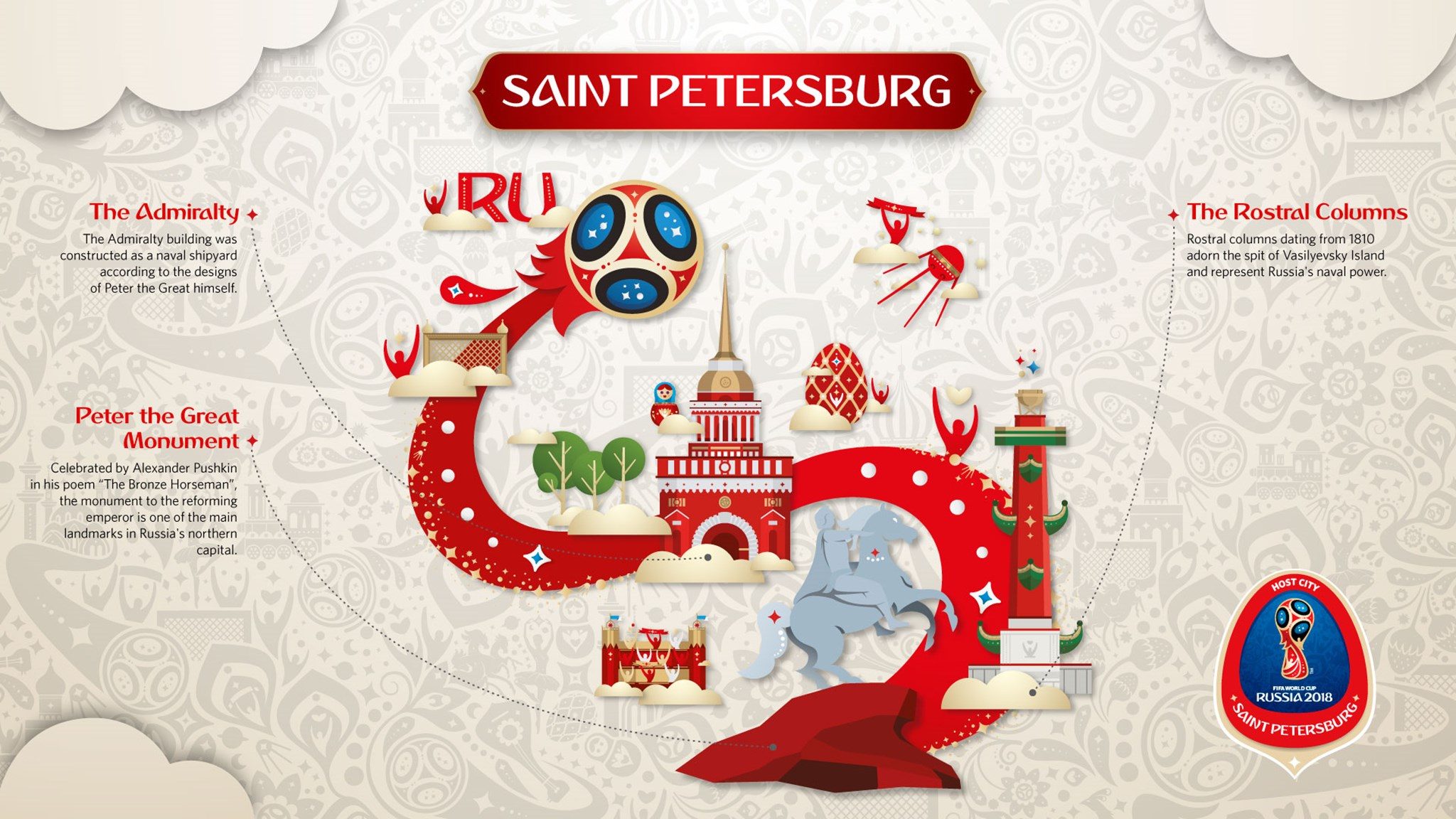
The northern capital will host games at the stadium of the same name. Construction was completed in 2017, the arena holds almost 68,000 spectators. A passage from Moscow by train FAN is free, as well as intraurban – of course, with a fan’s passport. Airports “Pulkovo-1” and “Pulkovo-2” in the fastest pace modernize the buildings and station areas to be ready for the influx of sports tourists.
On the North Palmira area there will be four group matches – 15, 19, 22, 26 June, 1/8 finals – 3 July, one semifinal match – 10 July and the game for third place – 14 July. Since hotels in St. Petersburg are quite expensive, and mini-hotels and hostels may not be enough for everyone, the city government has been puzzled by the opening of several dozen hotels 2* and 3*. So that the fans will not remain without a roof over their heads. Now the average price of a double room per night in a mini-hotel 2* is about 3500 rubles, for the championship this cost can grow by 15-20%.
In addition to the point of the Vasilievsky Island, the Aurora and the Hermitage are obligatory to visit Peterhof (better on a sunny day, if it will), the Peter and Paul Fortress, Kronstadt, St. Isaac’s Cathedral and, of course, the bridging of the bridges. The time of the matches will also allow you to admire the white nights.
Volgograd
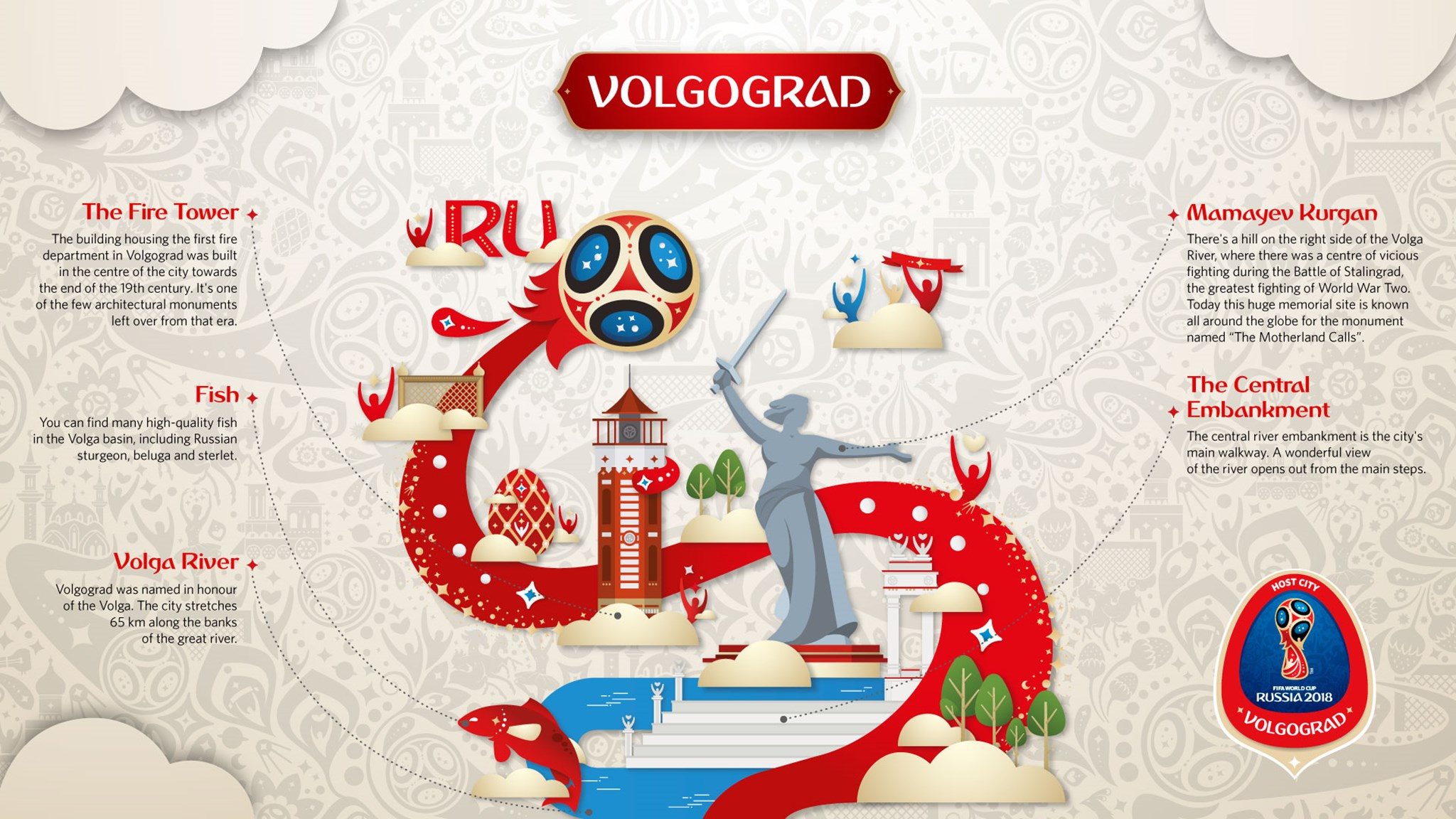
The Volga cluster of games is represented, among other things, by the millionth Volgograd. It is located almost a thousand kilometers from Moscow, in the lower reaches of the Volga. In addition to the open stadium “Volgograd Arena” for 45,000 seats, the city will provide three training areas for teams. June 18, 22, 25, June 28 at the stadium will be held the selection game.
Mamayev Kurgan, the sculpture “Motherland Calls,” the museum complex “The Battle of Stalingrad”, the Volga-Don Canal – all the sights in Volgograd are monumental and amaze with size and strict solemnity. They are worth seeing at least once in life.
Unfortunately, the rhythm of modern urban life does not always allow us to rest fully. However, you want to escape from Moscow for a few days, unwind, change the situation and see something new.
Fortunately, to arrange a small adventure, it does not necessarily have to have an extra bag of money. You can buy a train ticket and go to an unknown destination. Also, if you want certainty in your travels, then we can tell which cities are worth a visit. For example, Volgograd.
If you sit on the train on Friday evening, then the next day you can enjoy the sunset in a cafe on the Volga embankment. The journey time will be about 20 hours, and the ticket price usually starts from 1300 rubles.
In Volgograd, there is something to see and in addition to the wonderful sunsets. In particular, we recommend that you go to the Mamayev Kurgan. This height during the war became the site of bloody battles. Now here are the mass graves and the world-famous memorial ensemble “Heroes of the Battle of Stalingrad.” His business card is the monument “Motherland Calls!” At the time of construction, it was the tallest statue in the world. For 22 years, she retained the lead before giving way to the statue of the goddess Kannon in Japan. At the moment, the 85-meter Motherland is ninth in the world.
The entrance to the Mamayev Kurgan is free. In addition to the memorial complex on its territory, there is a temple and a museum of Stalin, for visiting which it is necessary to pay about 120 rubles.
Special attention of tourists deserves Volgograd Starry House. It is among the eight best planetariums in the world. Since its construction in 1954, it has been visited, according to the most conservative estimates, by more than 32 million guests.
The duration of the interactive program for guests of the planetarium is 1 hour. The session consists of an excursion, an experiment with the Foucault pendulum and a program in the Star Hall. The price of an adult ticket is 270 rubles.
Please note that in the upper foyer of the planetarium, fragments of two meteorites are on display for everyone, and for an additional fee, you can register with a local observatory to observe the starry sky through a telescope.
Before departure, take a walk along the embankment of Volgograd near the river port (on the map). Here you can take an ice cream or drink a cup of coffee, looking at the ships slowly sailing along the river. The embankment is not very far from the station, so you will have time to say goodbye to the city and, without haste, go to the train that will take you home.
Ekaterinburg
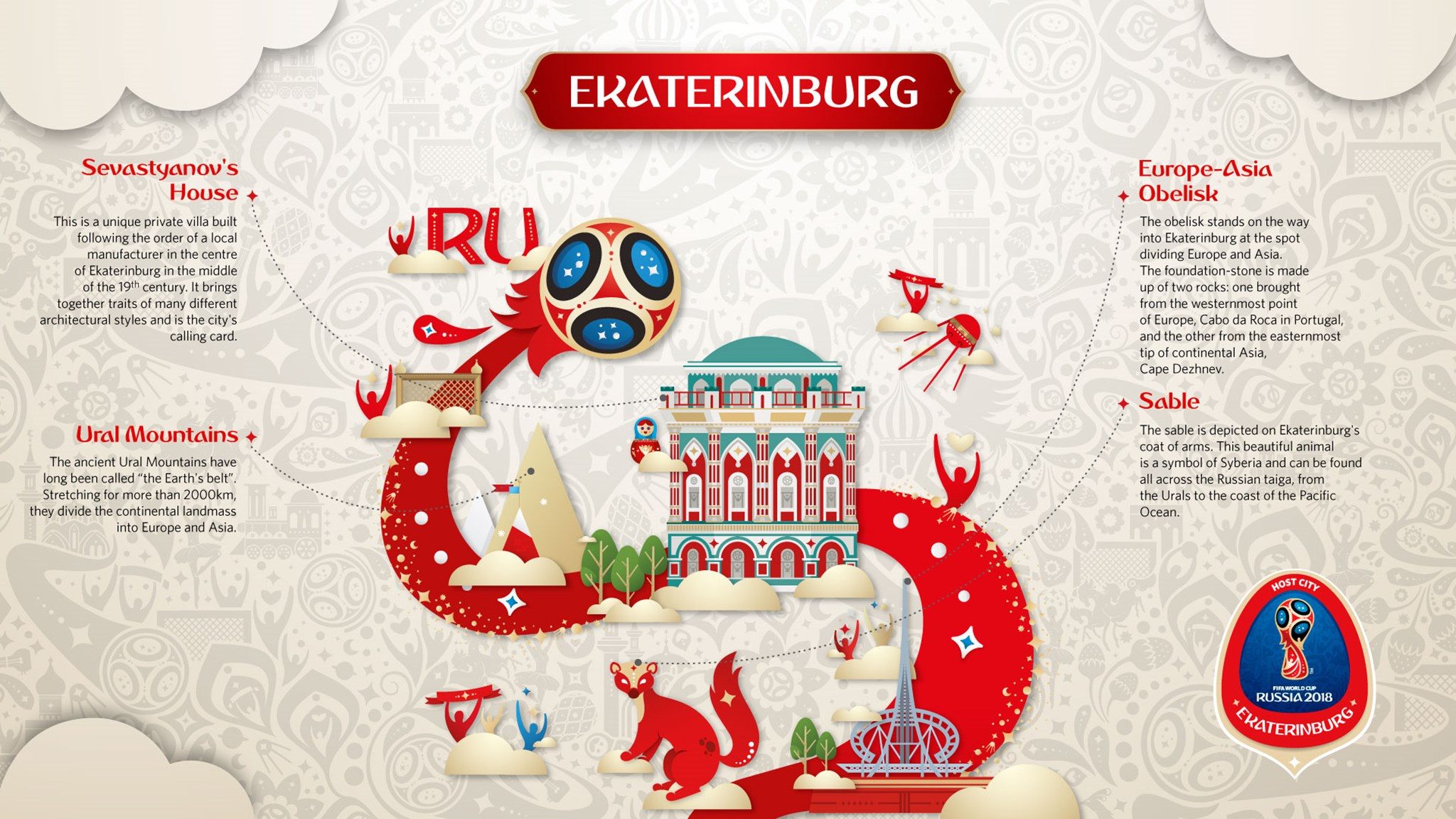
The capital of the Urals. The third largest city in terms of population and importance is Russia after Moscow and St. Petersburg. It is also the city of the World Cup, the farthest from the European mainland.
The Central Stadium was reconstructed in Ekaterinburg. Now it holds 35,000 spectators and for the time of the World Cup it will be called “Ekaterinburg-Arena”.
there will be four matches of the group stage in the Urals capital: June 15, 21, 24 and 27.
The cost of rent here is comparable to Volgograd.
If you want to feel the atmosphere of this city be sure to visit the Yeltsin Center (the museum in honor of the first Russian president Boris N. Yeltsin), the observation platform of BC Vysotsky (from which a magnificent view of the city opens), the Temple on Blood (where the family was shot by the last Russian Tsar – Nicholas II), stroll along Vainer Street (many shops and cafes) and the Plotinka (where you can see a panorama of all important objects).
Kazan
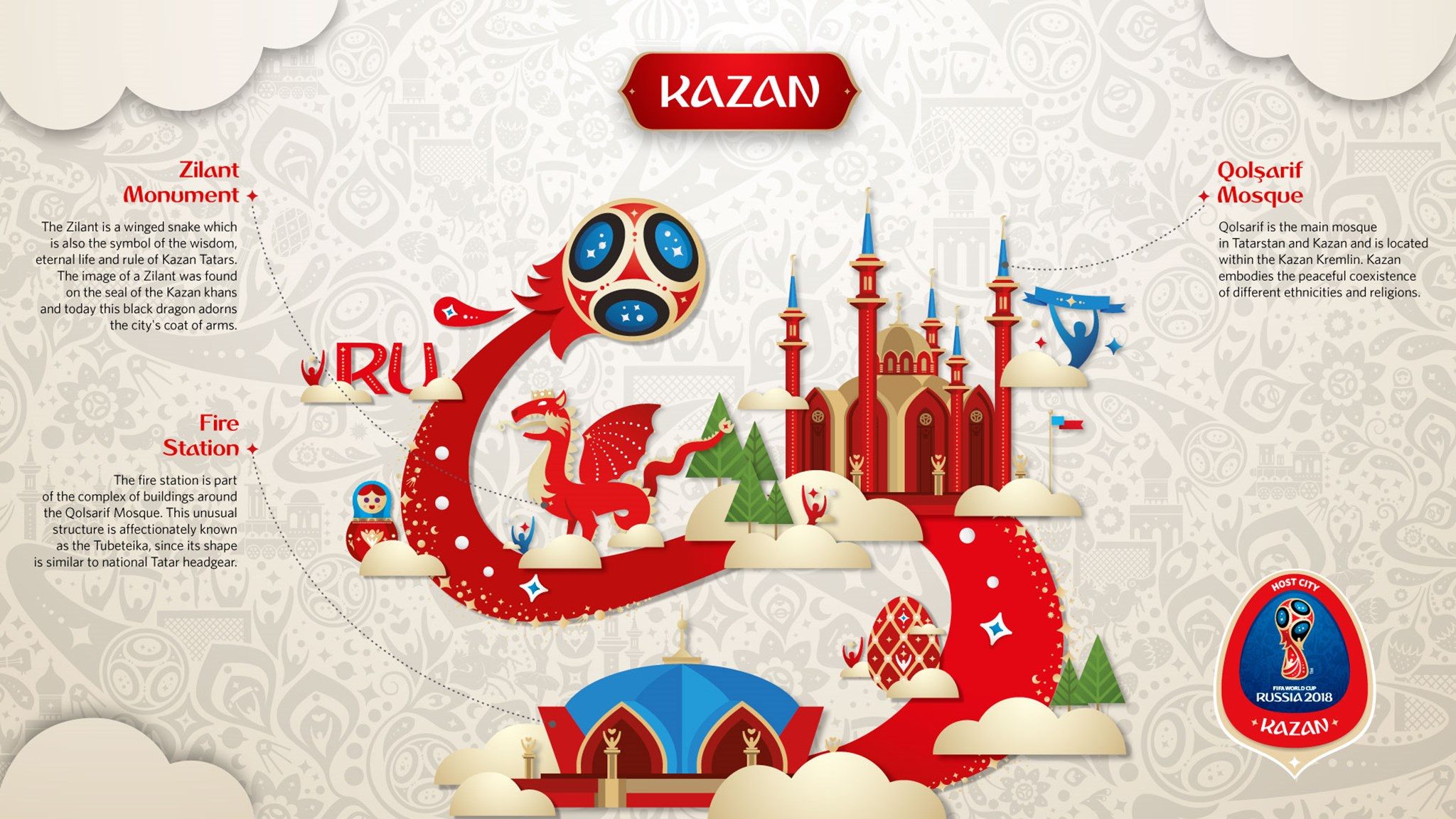
More than once hosted by Russian and international competitions and championships, the city is ready to meet the participants and guests of the mundial. “Kazan Arena” accommodates 45,000 spectators, who on June 16, 20, 24, June 27 will be able to attend the qualifying group games, and on June 30 and July 6 at 1/8 and 1/4 finals respectively. Also, in Kazan, there will be organized a training camp for the participating teams. The city, according to the authorities, is completely ready for the championship: all possible modernization of infrastructure, roads, hotel complex have been carried out. Inexpensive aparthotels can be rented on average from 1500 rubles per day.
Be sure to go through the historic center of the city: Kazan in beauty can compete not only with Russian tourist cities but also with European ones. The Kazan Kremlin, Millennium Park, the Millennium Bridge and the Temple of all religions will be certainly remembered.
Kazan is a unique city, a meeting place of Europe and Asia. Maybe, that’s why a special friendly atmosphere reigns here. Cobbled streets, monumental buildings, theaters, monasteries, the Volga bank – the capital as if descended from the pages of the guide to the most beautiful cities in the world. And if you have not been to the capital of Tatarstan, go ahead! The city is waiting for you!
Kaliningrad
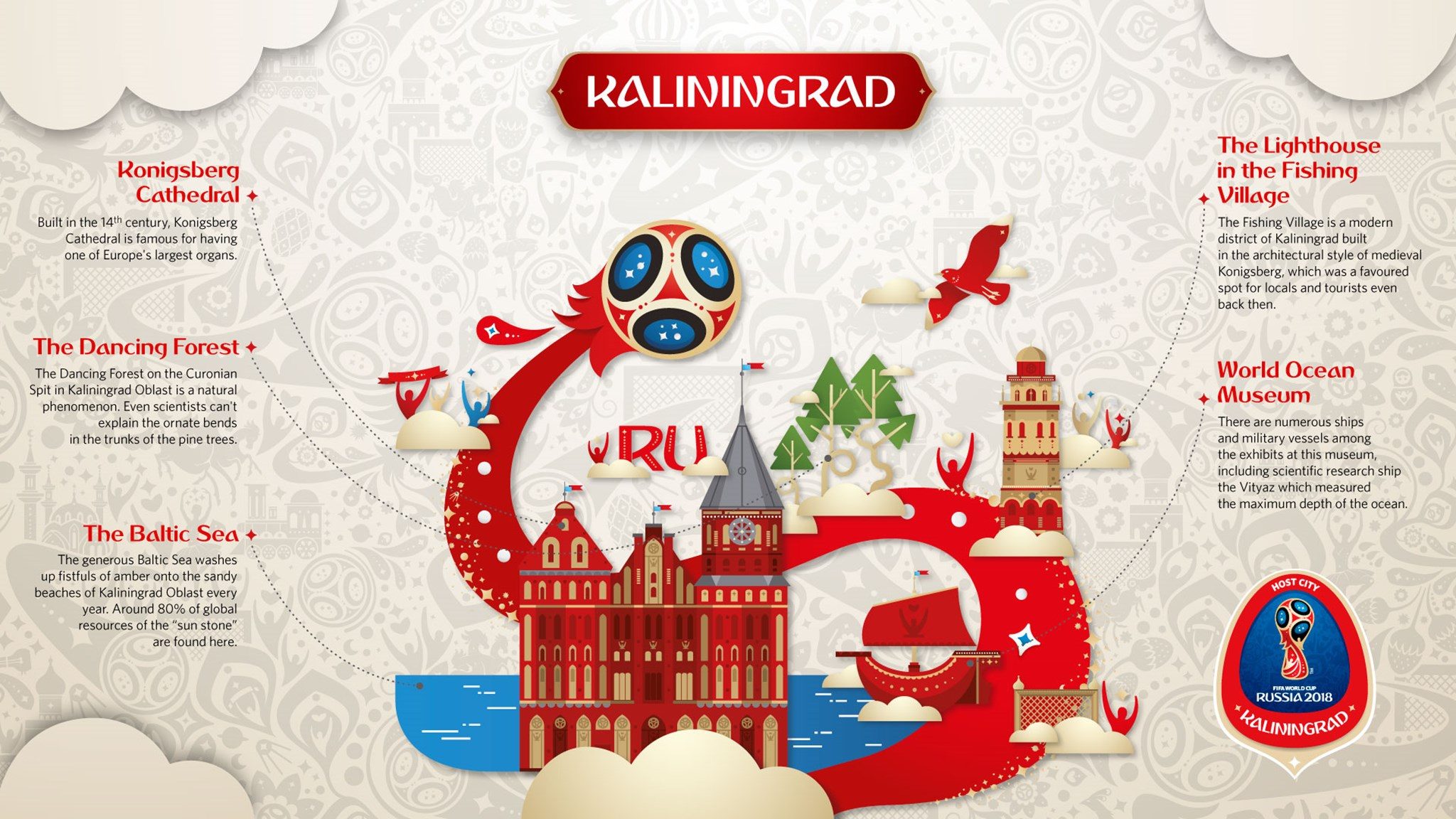
In contrast to Ekaterinburg – the most western point of the championship. Especially for the construction of the stadium “Kaliningrad” was drained and densified wetlands of soil. The open area will accommodate 35,000 spectators. 16, 22, 25, 28 the measured life of “Russian Europe” will explode with colored flags and “screamers” of the fans.
Football fans can reach Kaliningrad by plane: the airport “Khrabrovo” increases the capacity day by day. Direct trains run from Moscow and St. Petersburg, but this is not the most convenient way of transport. Accommodation is planned in hotels and hostels, as well as camping, which, according to the mayor’s office, will be able to provide temporary shelter for 29,000 fans. Intra-urban transport communication of the city is completely modernized. The fan zone is supposed to be equipped in front of the House of Soviets.
Before the match or after it is worth seeing the city: this is a bizarre mixture of old European, Soviet and modern Russian cultures. The cathedral, the amber museum, the World Ocean Museum, the Curonian Spit national park are just a partial list of places that are desirable to visit.
Nizhniy Novgorod

One of the closest to Moscow host cities is just 400 km away. The same venue for 45,000 spectators will host six FIFA World Cup matches: 18, 21, 24, 27 – group, 1 July – 1/8 finals and July 6 – quarter finals. By the way, there is a stadium in one of the most picturesque places of the city: on Strelka, where the Volga and the Oka merge.
In Nizhny Novgorod, in addition to the train fans, there is a high-speed “Swallow” – only 4 hours of the road. The work on improving the hotel complex is in full swing. While in the most inexpensive hostels you can find double rooms for 1200 per day, however, when calculating the travel budget, this figure should be increased by, at least, 15%.
Since the stadium is located in the heart of the city, it is easy to get to the main attractions: the Kremlin, Chkalovskaya stairs, Christmas Church and Bolshaya Pokrovskaya street. Separate entertainment – a trip along the cable car over the Volga and a trip to the Nizhny Novgorod fair.
Note: On the tourist portal of the FIFA 2018 World Cup in Russia there is a service with the help of which you can book rooms in the hotels of any of the city-organizers. There is also a guide to places of interest.
Rostov

At the stadium “Rostov Arena” will be held four group matches – 17, 20, 23, 26 June and the match 1/8 of the playoffs – July 2. The capacity of the site is 45 000 spectators. To get to Rostov-on-Don from Moscow it will be possible by train and plane – for the sake of the championship here the international airport “Platov” has been built from scratch, the pride of all the south of Russia. On the streets already there are signs in English. The Voroshilovsky Bridge has been rebuilt, roads and junctions, and the embankment are being modernized. On the assurances of the city authorities, the hotel fund will amount to 8000 rooms by the beginning of the mundial – this excludes hostels and apartments with daily rent.
Among the mast-bow attractions – Liventsovskaya fortress, Paramonovsky warehouses, Kumzhenskaya grove and … “Toilet on Newspaper” – the most famous toilet in the world.
For example, you can look at the Paramonovsky warehouses. They are located right in the center of the city and are a monument of federal significance. Despite the special status, in the post-war years the old warehouse buildings came into complete desolation. Now the buildings are ruins of red brick, inside which several springs are piercing to the surface. It turns out whole lakes and small waterfalls. The spectacle for the metropolis is unusual, so Paramonovsky warehouses have become a popular place for young people and wedding photographers.
Another great place for tourist photography is the Don River embankment. Here people like to relax and residents of the city. On the waterfront, you can book a boat trip or simply stroll along the water, admiring the colorful southern sculptures. Among the most well-known are the “Rostov woman”, “Gregory and Aksinya in the boat”, “Don-father” and many others.
During the Civil War, Rostov-on-Don was one of the centers of the White movement. This continued until the 1st Cavalry Army of Marshal Budennyi occupied the city in 1920. Echoes of those times can be found today. Take, for example, at least a monument to the cart, located at the southern entrance to Rostov-on-Don. Or the mansion of Wrangel, the famous leader of the White Movement. It was built in 1885 but is currently in decline.
Samara
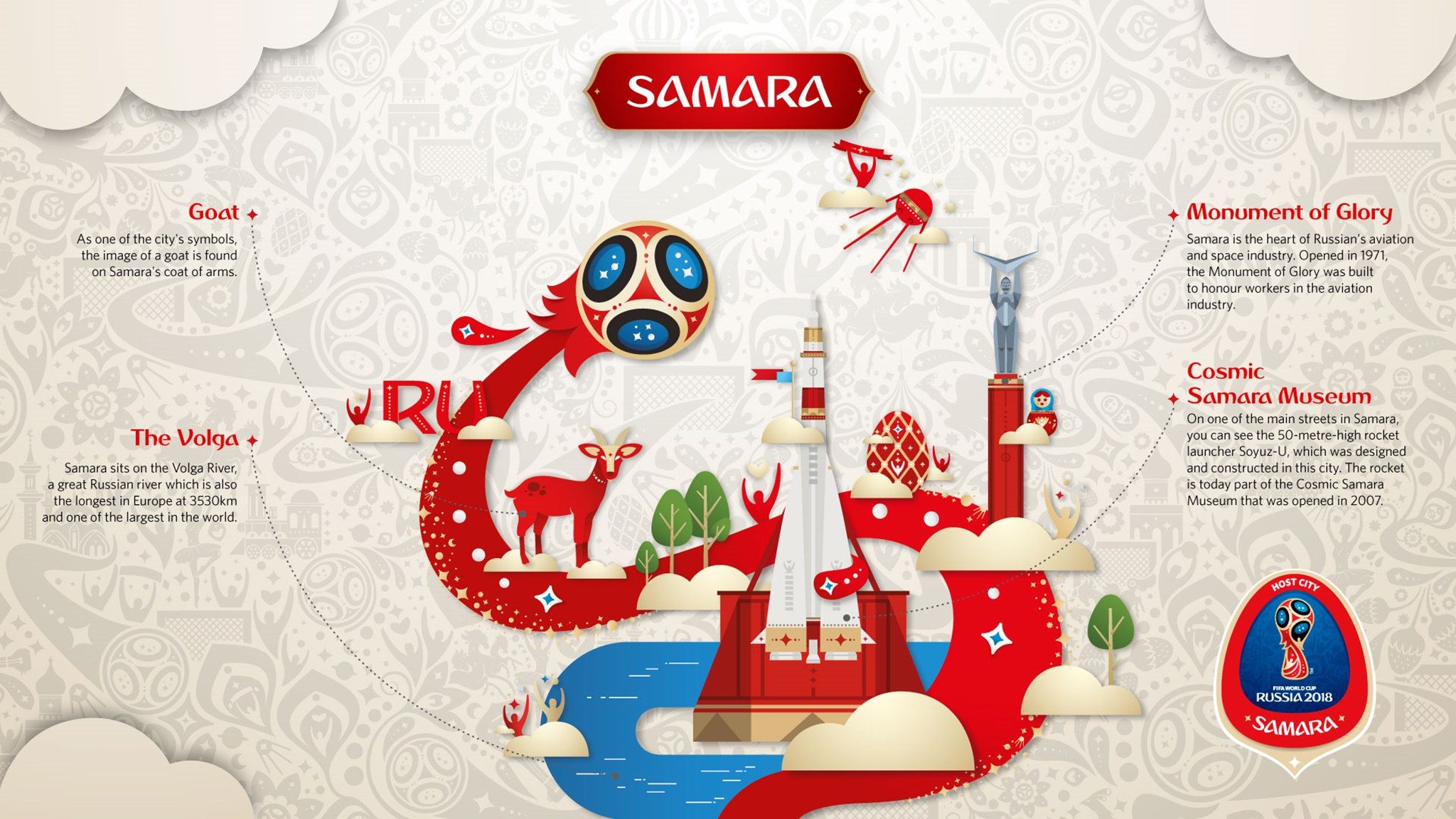
The city is located about 1000 km from Moscow, but you can get here either by train, plane or by car – directly on the M-5 highway. In Samara, it is planned to hold six football meetings: 17, 21, 25, 28 June – group, July 2 – 1/8 finals and July 7 – quarterfinal. Games will be held at the stadium “Samara Arena” (also “Space Arena”) – a two-story open stadium for 45 000 spectators, with a natural lawn.
For the convenience of sports tourists, it is planned to launch a tram line from the railway station to the stadium, as well as build a new river dock on the embankment near the “Samara Arena” and update the fleet of ships. International airport “Kurumoch” increased the capacity to 40 million passengers a year. Accommodation of tourists is planned both in hotels – according to the city authorities, the fund makes more than 18 000 numbers, and in more modest conditions: up to the converted railway cars.
In Samara, it is necessary to ride along the coast on a pleasure boat: so you can appreciate the beauty of the Volga, and the sights of the city. Fans of technology like the museum “Samara Space”, lovers of history – “Stalin’s Bunker.”
Saransk
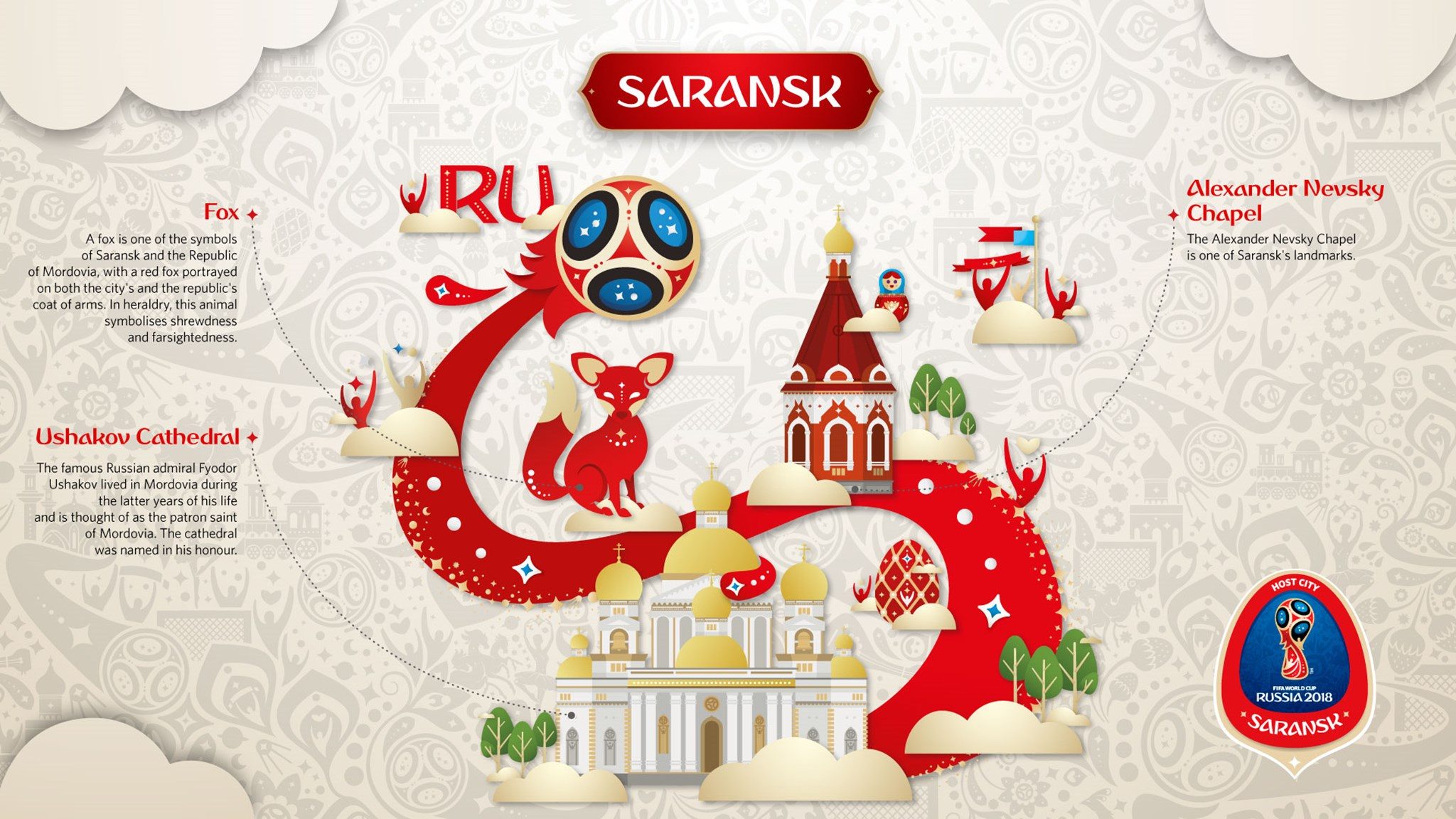
The smallest of the host cities is included in the Volga cluster. At the stadium “Mordovia Arena”, there will be four qualifying matches: 16, 19, 25, 28 June. For the period of the games, the capacity of the stadium will reach 45,000 spectators, and then it will be reduced to 30,000. The stadium is just 2.5 km from the railway station. For transportation of fans from the airport, it is planned to launch special buses-transfers. Since the construction of large hotels would be unprofitable – after all, this is not the most visited city, an agreement was concluded with the company Snoozebox on the delivery of mobile hotels to the city during the World Cup. Each demountable hotel can have up to 2000 rooms. The maximum price set by the organizing committee for the cheapest rooms is 2610 rubles.
In Saransk, a large park is planned to be set up for the championship, but apart from it, there is a lot to go: the original museum of the fine arts named after S.D. Erzy, Sobornaya square, memorial museum of military and labor feats, historical and ethnographic complex “Mordvovskoe podvorye”.
Sochi

The pride of the whole Russia – a unique mountain-and-sea resort has become accustomed to receiving major international competitions. Of course, it was included in the program of the 2018 World Cup. The beautiful modern stadium “Fisht” is familiar to everyone else on the Olympic Games. He will take four group matches on 15, 18, 23, 26 June, 1/8 finals on June 30 and 1/4 playoffs on July 7. Also in Sochi will open a training base and a hotel complex “Parus” for participating teams. For the fans will also be created the most comfortable conditions – the modernization of hotels and boarding houses continues. Well, Russian tourists are not accustomed to rent houses of local residents. However, it is worthwhile to be prepared, that already high in the season prices will soar.
With transport in Sochi there are no problems: you can go by train or by car, fly by plane. The mayor’s office promised to solve the problems with traffic jams and urban transport.
It will not be surprising if the fans who come to the match try to stay at the resort for at least a few more days: the Black Sea attracts no less than the mountain peaks, waterfalls, and caves. The city itself can be viewed from the Ferris wheel, or you can walk along the streets of the city, visiting the Sochi National Park, the Olympic Park, the arboretum. Mast-si – Mount Ahun and the Riviera Park.
Sochi is a Russian city on the Black Sea, a popular beach resort. In 2014, the Winter Olympic Games were held here. One of the main attractions of the city is the arboretum known for its palm trees. Also, the city is famous for the neoclassical buildings of the XX century, such as the Winter Theater with a colonnade. At the foot of the Caucasus Mountains is a national park – a forest area of 1937 square kilometers. In 70 kilometers from the sea the famous ski resort Krasnaya Polyana is located.
STADIUMS FIFA 2018
Luzhniki
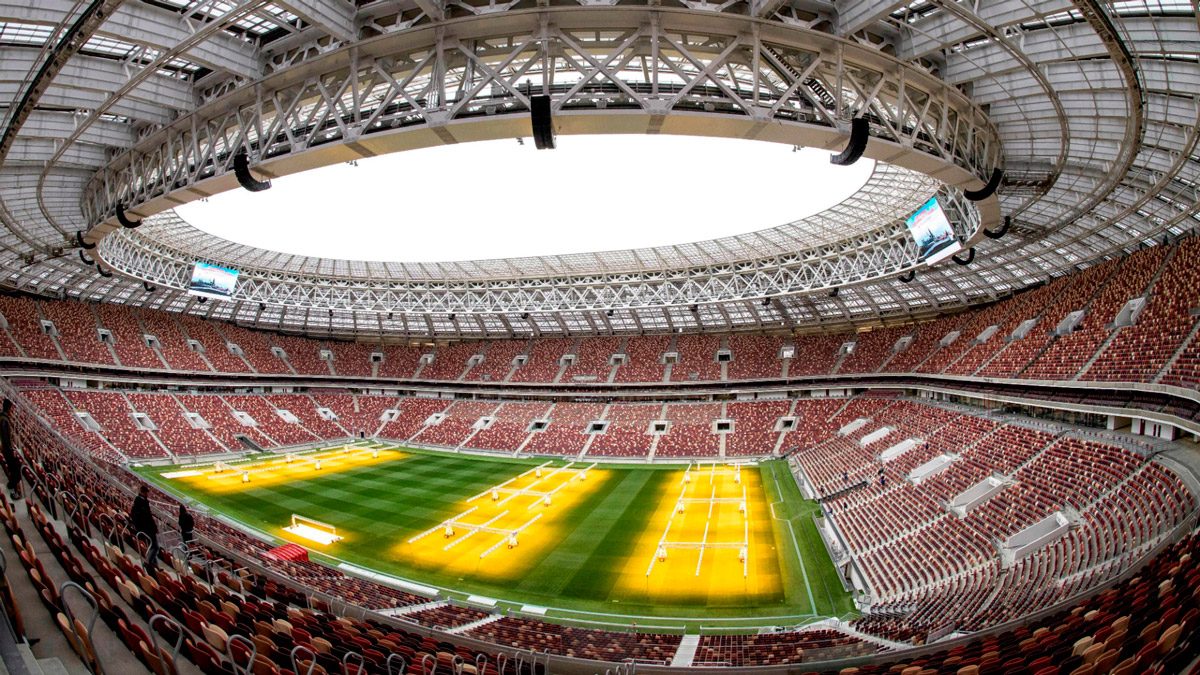
“Luzhniki” was the most capacious stadium of the USSR and Russia, and after reconstruction again became the main and largest stadium of the country.
All places of the Grand Sports Arena stadium closed erected in 1997, the peak width of 63.5 meters and a weight of 15,000 tons, which hold 72 steel towers 26 meters high each. Since August 2008, the stadium had a football field with an artificial cover of the fifth generation. There were running tracks around it. At the stadium – four connected stands. Tribune A – main, B and D – side, usually B – fan, and D – guest. One color board is installed on them. On the platform “A” there are VIP-sectors and a VIP-box.
In 1996-1997 the capital reconstruction of the stadium was carried out. A stationary roof was built, the stands were repaired, their covering was installed and 80 650 seats were installed, the covering of the running field and the zone behind the football field was replaced, and screens were installed. To the World Cup in 2018, the stadium was reconstructed, which included a possible replacement of screens, a complete replacement of the running cover for blue, the conversion of part of the tribune C to the usual installation of 81 thousand seats.
In addition to the indoor halls, the stadium has the North and South sports cores, located respectively from the north and south of the Grand Sports Arena. These are additional outdoor sports grounds intended for training teams and competitions in football and mini-football, tennis and track and field athletics, with adjacent single-storey buildings (auxiliary rooms for changing teams).
Spartak (Otkrytie Arena)
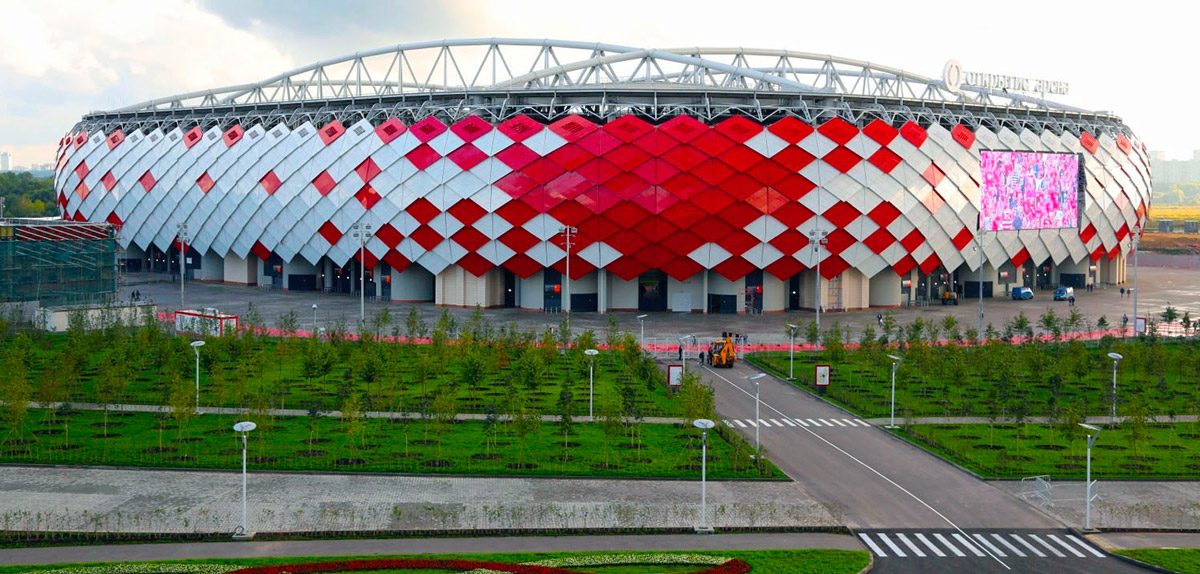
“Otkrytie Arena” (non-commercial name – Stadium “Spartak”) – the stadium in Moscow, the home arena of the Moscow football club “Spartak”. The capacity of the stadium is 45 360 people. It is included in the list of facilities that host matches of the Confederations Cup 2017 and the 2018 FIFA World Cup. The opening match took place on September 5, 2014, when “Spartak” met with the Serbian club “Crvena Zvezda” (1: 1).
The stadium “Spartak” accommodates up to 45,000 spectators. As recognized by contractors, in the process of its construction it was required to ensure a high level of security, up to the device of fire protection of communications. This solution is necessary, as during a fire pipes can burn out, and then in the places of their passage through walls and other partitions the way for spreading the fire will open. So, for example, air ducts of ventilation and air conditioning systems from a thin-walled steel sheet in case of fire development can withstand no more than 15 minutes. To protect engineering systems, Rockwool 100 rock wool cylinders and WIRED MAT 80 material were used. They will allow the pipes to maintain their integrity even when exposed to critically high temperatures.
Samara Arena
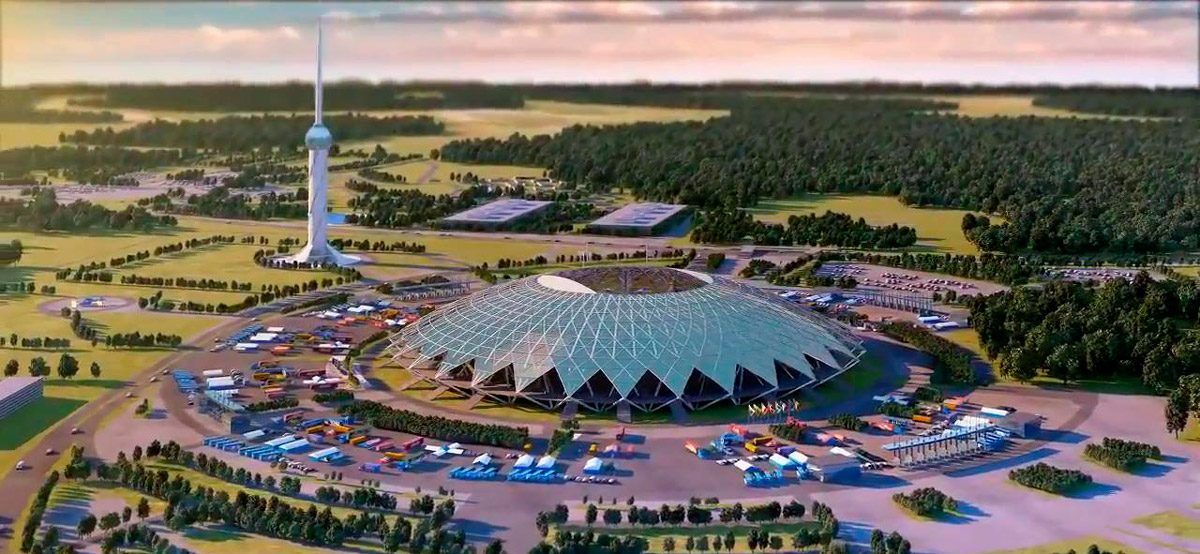
“Samara Arena” is the most problematic stadium. In early 2017, Deputy Prime Minister Vitaly Mutko called him the only “lagging” stadium, but he expected the construction to return to the schedule in 1.5 months. In October last year, the Minister of Sports Pavel Kolobkov estimated the degree of readiness of the facility in 65%, at the same time the general contractor – the JI “Kazan” – was almost fined for the failure to meet construction deadlines. On April 27, the stadium received permission for commissioning. The next day the arena took the first test match.
The cost of the Samara stadium grew several times: first, it was estimated at 13 billion rubles, then – 16 billion, in 2015 – 17.6 billion. The total cost of construction amounted to 18.9 billion rubles. The stadium in Samara in terms of building area and height is almost like Luzhniki, but its capacity is half that – 45,000 seats against 81,000.
Stadium Saint-Petersburg
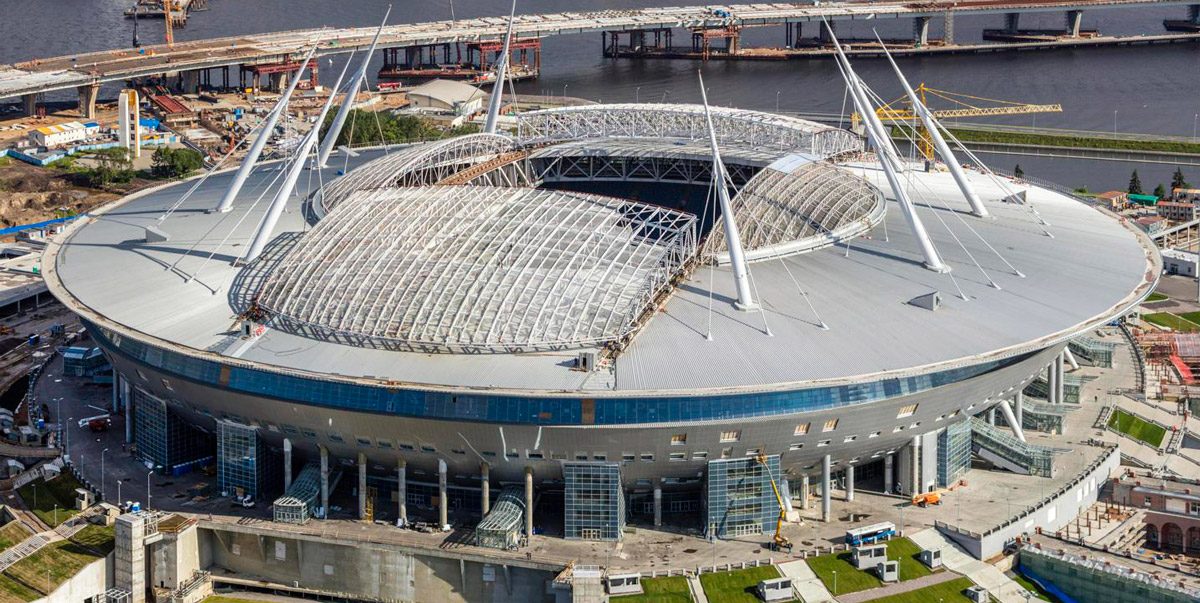
The stadium in St. Petersburg was opened in 2017. It hosted the Cup of Confederations, including the opening match and the final. The stadium was built almost 10 years and costs about 43 billion rubles. It is designed for 68,500 spectators.
The stadium in St. Petersburg is the only stadium in Russia with a sliding roof.
Stadium Kaliningrad
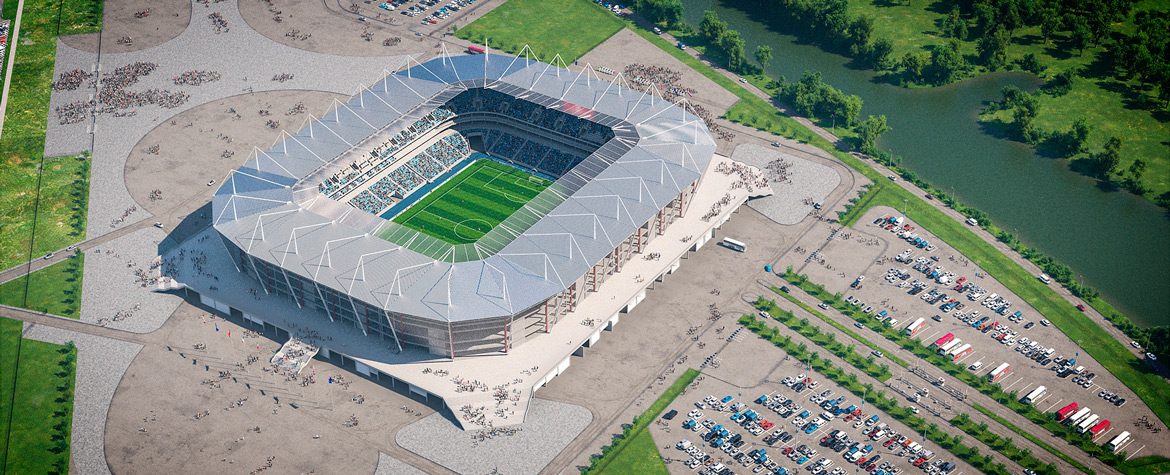
At the stadium in Kaliningrad will be four matches of the group stage of the World Cup: Croatia – Nigeria, Serbia – Switzerland, Spain – Morocco and England – Belgium. The arena was built on a wetland site on the Oktyabrsky Island and received permission for commissioning on 23 March.
Construction of the stadium in Kaliningrad cost 17.85 billion rubles: said RBC president of the general contractor – the company Crocus Group – Aras Agalarov. The capacity of the stadium is 35 000 people.
Volgograd Arena
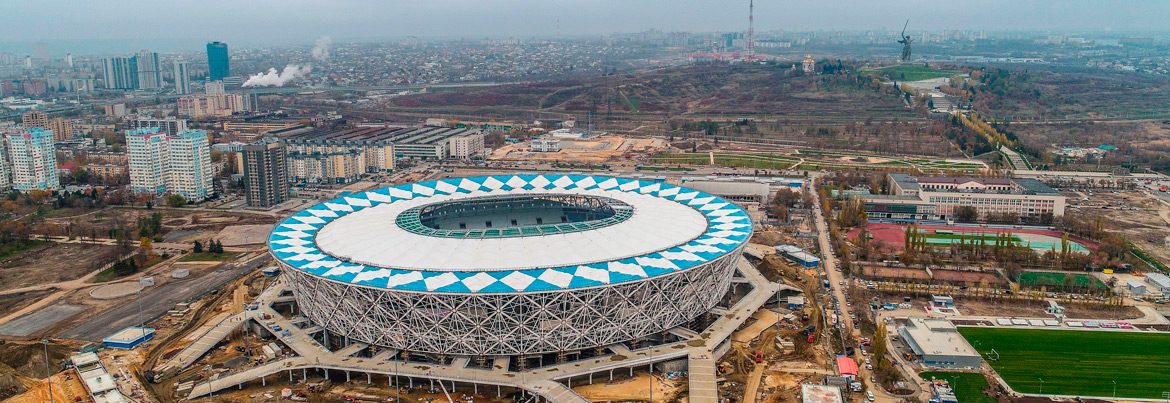
“Volgograd arena” on May 9 took the final match of the Cup of Russia. The capacity of the stadium is 45 000 people.
The Arena in Volgograd is built on the site of an old stadium belonging to the football club Rotor. The cost of construction – 16.367 billion rubles.
Ekaterinburg Arena
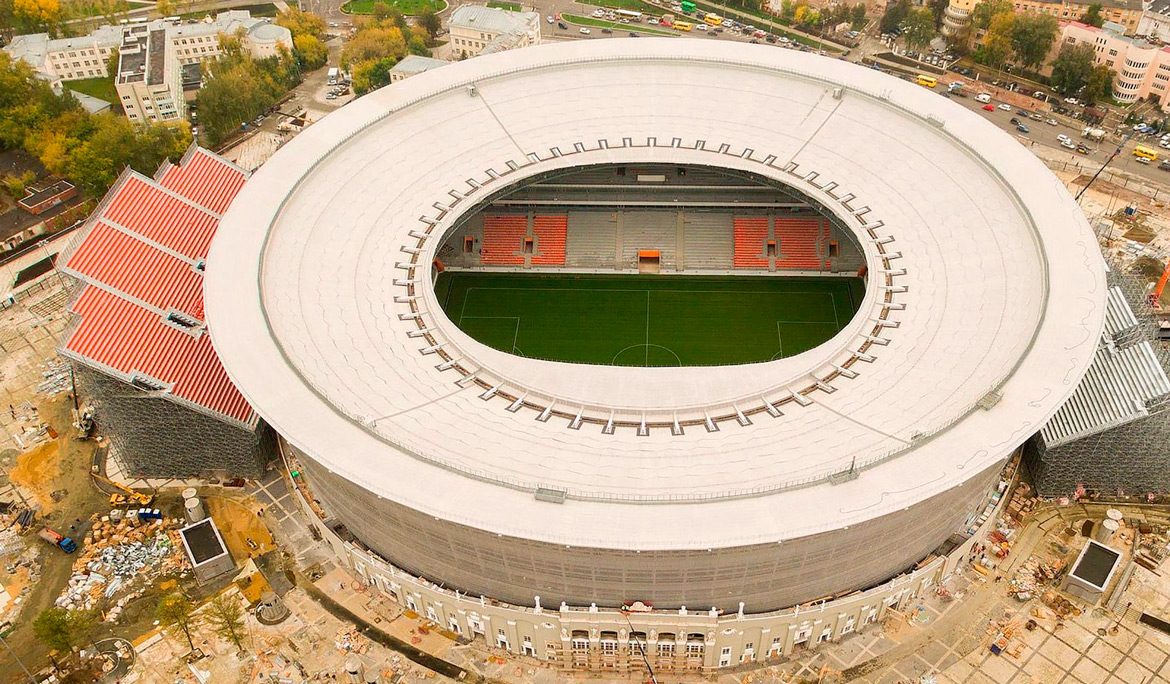
The official opening of the stadium “Ekaterinburg Arena” was held on April 15. The stadium was built in 1953, after which it was repeatedly restored. The last time the arena was reconstructed for the 2018 World Cup. The historical façade of the stadium was left intact, as it is an object of architectural heritage.
The capacity of the arena in Ekaterinburg is 35,000 people. The cost of reconstruction amounted to 12.7 billion rubles.
Stadium Nizhniy Novgorod
At the stadium in Nizhny Novgorod will be four matches of the group stage of World Cup 2018 and one match of 1/8 and 1/4 finals. The capacity of the arena is 45 000. The stadium was officially opened on 6 May before the third test match.
The arena in Nizhny Novgorod was built on budgetary funds by the general contractor of Stroytransgaz Gennady Timchenko. The cost of the project is 17.018 billion rubles.
Mordoviya Arena
At the stadium “Mordovia arena” will be held four matches of the group stage of the 2018 World Cup. The capacity of the arena is more than 45 000 people. Construction of the stadium began in 2010 and cost the budget 15.8 billion rubles.
The first test match in the arena in Saransk was on April 21, the second – on May 4.
Rostov Arena
The stadium in Rostov-on-Don was put into operation for the World Cup on March 17. The arena is designed for 45,000 spectators.
About the World Cup 2018 in Rostov-on-Don will play teams of Brazil and Switzerland, Uruguay and Saudi Arabia, South Korea and Mexico, Iceland and Croatia.
Kazan Arena
The stadium in Kazan was built in preparation for the Universiade in 2013 – the opening and closing ceremonies of the Universiade were held in the arena. After that, a football field was established at the stadium. In 2017 Kazan Arena hosted the Cup of Confederations.
The capacity of the stadium is 45,000 people; the construction cost more than 14 billion rubles.
Stadium Fisht
The stadium was named after the mountain peak of the same name in the western part of the Main Caucasian Range (in the translation from the Adyghe language the word “fish” means “white head”). Originally, it was planned that the appearance of the stadium would resemble the Easter egg Faberge. As a result, a project was approved that uses images of both the shell and the snow top. The stadium has four stands: two lateral, covered with a translucent polycarbonate, and two end, open.
The location of the stadium and the height of the podium tribune were supposed to provide viewers with a beautiful view of the Greater Caucasus Mountains, but the project was changed and a temporary roof was built. The stadium is designed for 40,000 spectators for the Olympics, 45,000 spectators for international football matches and 25,000 spectators for less important shows. “Olympic Stadium” entered the list of stadiums that host the 2018 FIFA World Cup.
The stadium is located on the site of the former Marlinsky settlement in the Imereti lowland, where, in particular, the Old Believers also lived. Near the village, there is an active ancient cemetery of Old Believers with an area of about 1 hectare, which had not been applied to the city plans of the territory. While building the stadium, the cemetery was preserved, and now it is located in the middle of the Olympic Park in Sochi, but hidden by an opaque plastic fence, densely planted with evergreen thuja.
Transport
Despite many scandals, Russia remains a friendly and an affable country. Organisers have chosen the most populated and developed cities in the European part of Russia, such as: Yekaterinburg, Moscow, St. Petersburg, Kaliningrad, Rostov-on-Don, Kazan, Nizhny Novgorod, Samara, Sochi, Saransk and Volgograd. If you have the FAN ID, you are guaranteed to have the right to use public transport free of charge during matches. In six of the venues there is the Metro available, which will be open 24 hours a day. Moreover, you can travel by bus, tram and taxi as well. Also, in some of the cities, there exist cards (like Moscow Troika card) that allow all public transport systems to be used at a very economical price. If you prefer traveling by taxi, in Russia there are several companies that have online booking or mobile applications. For example: Uber, Gettaxi or KiwiTaxi.
However, there are some things you should know about traveling in Russia:
- You can buy tickets in websites (rossiya-airlines.com, aeroflot.ru, airlines-inform.ru). We highly recommend you to buy them in advance if you would like to get the best price. Also, you can use sites like Momondo to get the best fares. You will be able to fly to host-cities like Moscow and St., Petersburg, which will last less than three hours. The longest to fly are Sochi and Yekaterinburg.
- If you don’t have enough money to buy airplane tickets, train will be your best alternative. It goes through every one of the host cities. Furthermore, the tickets are not expensive and can be bought on the official website — russiable.co.uk. If you wonder how to do it, you can read the instruction on the site mentioned above. Also, the FAN ID grants the right to use trains for free (in case you pre-booked the tickets)!
- Bus is the cheapest variant of all, although the least comfortable and takes long time to reach the place of your destination (6 to 12 hours). You can book tickets using infobus.eu.
If you have an idea of traveling by car, we must say it is not the best idea, since roads in Russia are rather bad and the distance between cities is big.
PARTICIPANTS
- Argentina
- Australia
- Belgium
- Brazil
- Colombia
- Costa Rica
- Croatia
- Denmark
- Egypt
- England
- France
- Germany
- Iceland
- Iran
- Japan
- Mexico
- Morocco
- Nigeria
- Panama
- Peru
- Poland
- Portugal
- Russia
- Saudi Arabia
- Senegal
- Serbia
- South Korea
- Spain
- Sweden
- Switzerland
- Tunisia
- Uruguay
GROUP STAGE
Group A
| Date | Home | Score | Visitors | Town |
|---|---|---|---|---|
| 14 Jun 2018 (18:00 Local time) | 5-0 | |||
| 15 Jun 2018 (15:00 Local time) | 1-2 | |||
| 19 Jun 2018 (21:00 Local time) | 3-1 | |||
| 20 Jun 2018 (18:00 Local time) | 1-0 | |||
| 25 Jun 2018 (18:00 Local time) | 3-0 | |||
| 25 Jun 2018 (17:00 Local time) | 2-1 |
Group B
| Date | Home | Score | Visitors | Town |
|---|---|---|---|---|
| 15 Jun 2018 (18:00 Local time) | 0-1 | |||
| 15 Jun 2018 (21:00 Local time) | 3-3 | |||
| 20 Jun 2018 (15:00 Local time) | 1-0 | |||
| 20 Jun 2018 (21:00 Local time) | 0-1 | |||
| 25 Jun 2018 (20:00 Local time) | 2-2 | |||
| 25 Jun 2018 (21:00 Local time) | 1-1 |
Group C
| Date | Home | Score | Visitors | Town |
|---|---|---|---|---|
| 16 Jun 2018 (13:00 Local time) | 2-1 | |||
| 16 Jun 2018 (19:00 Local time) | 0-1 | |||
| 21 Jun 2018 (16:00 Local time) | 1-1 | |||
| 21 Jun 2018 (20:00 Local time) | 1-0 | |||
| 26 Jun 2018 (17:00 Local time) | - | |||
| 26 Jun 2018 (17:00 Local time) | - |
Group D
| Date | Home | Score | Visitors | Town |
|---|---|---|---|---|
| 16 Jun 2018 (16:00 Local time) | 1-1 | |||
| 16 Jun 2018 (21:00 Local time) | 2-0 | |||
| 21 Jun 2018 (21:00 Local time) | 0-3 | |||
| 22 Jun 2018 (18:00 Local time) | 2-0 | |||
| 26 Jun 2018 (21:00 Local time) | - | |||
| 26 Jun 2018 (21:00 Local time) | - |
Group E
| Date | Home | Score | Visitors | Town |
|---|---|---|---|---|
| 17 Jun 2018 (16:00 Local time) | 0-1 | |||
| 17 Jun 2018 (21:00 Local time) | 1-1 | |||
| 22 Jun 2018 (15:00 Local time) | 2-0 | |||
| 22 Jun 2018 (20:00 Local time) | 1-2 | |||
| 27 Jun 2018 (21:00 Local time) | - | |||
| 27 Jun 2018 (21:00 Local time) | - |
Group F
| Date | Home | Score | Visitors | Town |
|---|---|---|---|---|
| 17 Jun 2018 (18:00 Local time) | 0-1 | |||
| 18 Jun 2018 (15:00 Local time) | 1-0 | |||
| 23 Jun 2018 (18:00 Local time) | 1-2 | |||
| 23 Jun 2018 (21:00 Local time) | 2-1 | |||
| 27 Jun 2018 (17:00 Local time) | - | |||
| 27 Jun 2018 (19:00 Local time) | - |
Group G
| Date | Home | Score | Visitors | Town |
|---|---|---|---|---|
| 18 Jun 2018 (18:00 Local time) | 3-0 | |||
| 18 Jun 2018 (21:00 Local time) | 1-2 | |||
| 23 Jun 2018 (15:00 Local time) | 5-2 | |||
| 24 Jun 2018 (15:00 Local time) | 6-1 | |||
| 28 Jun 2018 (20:00 Local time) | - | |||
| 28 Jun 2018 (21:00 Local time) | - |
Group H
| Date | Home | Score | Visitors | Town |
|---|---|---|---|---|
| 19 Jun 2018 (15:00 Local time) | 1-2 | |||
| 19 Jun 2018 (18:00 Local time) | 1-2 | |||
| 24 Jun 2018 (20:00 Local time) | 2-2 | |||
| 24 Jun 2018 (21:00 Local time) | 0-3 | |||
| 28 Jun 2018 (18:00 Local time) | - | |||
| 28 Jun 2018 (17:00 Local time) | - |
Predictions
According to the experts these six teams have the utmost chances to win at the World Cup 2018. The list includes:
- Belgium – The team have probably the best all-round players such as Kevin De Bruyne, Thibaut Courtois and Dries Mertens. Eden Hazard and Romelu Lukaku are not forgotten as well. Despite the fact that some of the players have injuries, Roberto Martínez’s 3-4-3 system must surely make them redoubtable this year.
- Argentina – Jorge Sampaoli’s tactics are not that stable, although if he manages to find the right balance, Argentina might have all chances to go straight to the final and, perhaps, even win this year with the help of universally known star player Lionel Messi. In spite of their probable nervousness, Argentina’s fans still hope the team is going to show everybody their ‘winning style’.
- France – France team’s fans do not stop asking whether Paul Pogba performs, if Antoine Griezmann shows his best and whether Hugo Lloris cuts out the mistakes he makes for Spurs at this year’s World Cup. Anyway, a talented coach could make a competitive squad from those who left out of their team.
- Brazil – Brazil team’s fans wish the team was the same as now four years ago. It is now much more good-balanced, experienced and skilled. Their qualification pleasantly shocked everyone, although their No 10 has broken his toe in February and since then has not had enough training.
- Germany – Those who hesitate when it comes to Germany team should remember the fact that two players over 30 are quite experienced and a very talented coach Joachim Löw. Such combination will doubtlessly make the performance at World Cup 2018 unforgettably impressive.
- Spain – The mix of youth and adult experience qualified excellently this year. Spain’s unique players can score a modest seven goals in a fractured domestic season, so there’s absolutely no doubt they will show their best at the tournament.
Although in the very beginning the World Cup was not universally supported and took its organizers many years and efforts to build what we have now and a number of live spectators barely consisted of 80.000, the tournament becomes more and more popular each year, connecting people all around the world. The agony and ecstasy combine and there comes the World Cup 2018.

